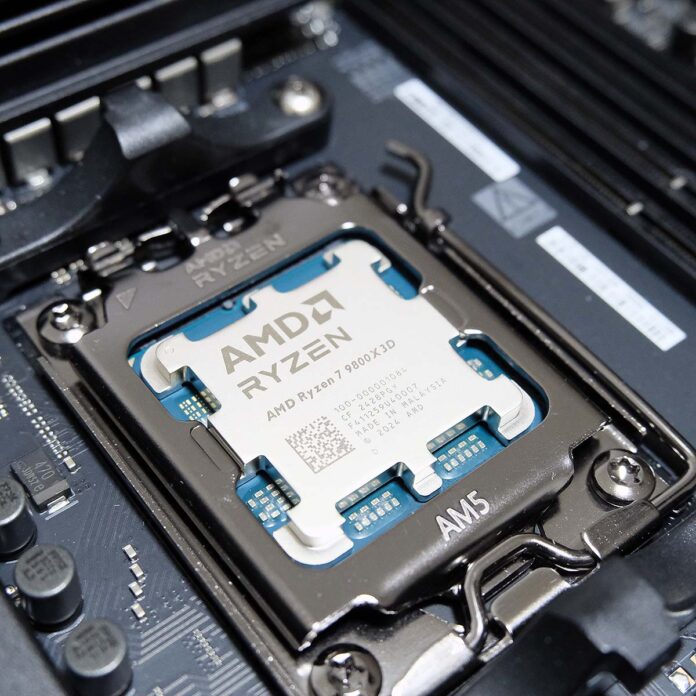Credit where it’s due. AMD’s done a sterling job in promoting nascent L3 cache-boosted X3D chips as the premier destination for gamers. Ryzen 7 5800X3D stoked plenty of interest, while Ryzen 7000 expanded reach with four models.
Furthermore, AMD’s acutely aware that springing a Ryzen 9000 Series X3D cohort on eager gamers is potentially counter-productive as it takes shine off regular chips. First-world problems, eh. The solution is to release just one. Enter the fold, Ryzen 7 9800X3D.
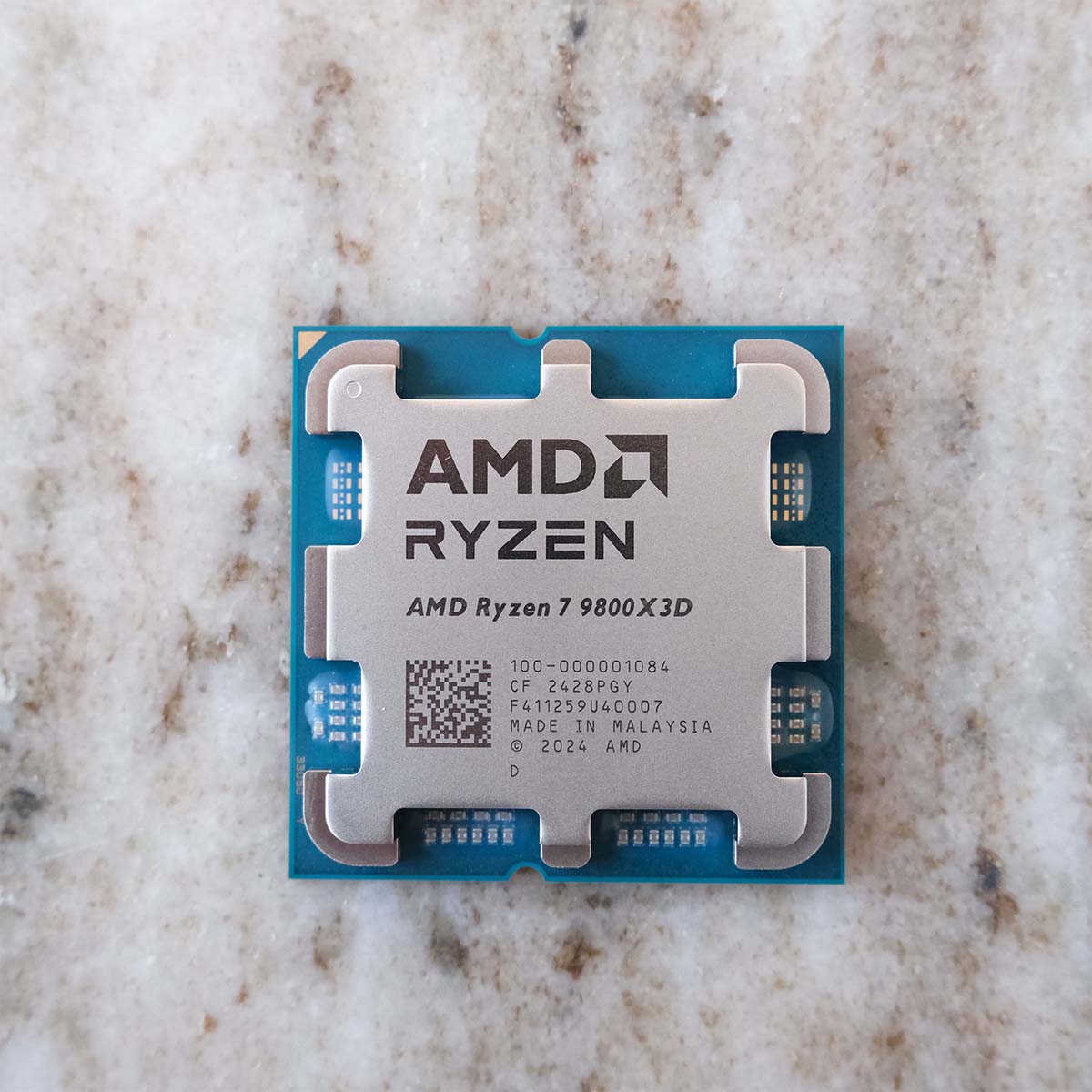

AMD Ryzen 7 9800X3D
£450 / $479
Pros
- Outstanding gaming performance
- Impressive multi-core chops
- Drop-in AM5 upgrade
- Reasonably energy efficient
Cons
- Limited overclocking
Club386 may earn an affiliate commission when you purchase products through links on our site.
How we test and review products.
Following on from August’s two-step launch, Ryzen 7 9800X3D enters the fray with only one intent: to be the fastest consumer gaming CPU in the world. Shouldn’t be too hard a task as Intel’s recent Arrow Lake CPUs have failed to impress in this regard.
Analysis
There’s nothing outwardly remarkable about Ryzen 7 9800X3D. It’s a Zen 5-based chip housing eight cores and 16 threads. I imagine most AM5 motherboards will support it via a simple BIOS update, and I had no issue in booting the CPU on multiple X670E and X870E platforms.
| Model | Cores Threads | TDP | L3 Cache | Base Clock | Boost Clock | MSRP |
|---|---|---|---|---|---|---|
| 9000 (2024) | ||||||
| Ryzen 9 9950X | 16 / 32 | 170W | 64MB | 4.3GHz | 5.7GHz | $649 |
| Ryzen 9 9900X | 12 / 24 | 120W | 64MB | 4.4GHz | 5.6GHz | $499 |
| Ryzen 7 9800X3D | 8 / 16 | 120W | 96MB | 4.7GHz | 5.2GHz | $479 |
| Ryzen 7 9700X | 8 / 16 | 65W | 32MB | 3.8GHz | 5.5GHz | $359 |
| Ryzen 5 9600X | 6 / 12 | 65W | 32MB | 3.9GHz | 5.4GHz | $279 |
| 7000 (2022) | ||||||
| Ryzen 9 7950X | 16 / 32 | 170W | 64MB | 4.7GHz | 5.7GHz | $699 |
| Ryzen 9 7900X | 12 / 24 | 170W | 64MB | 4.7GHz | 5.6GHz | $549 |
| Ryzen 7 7800X3D | 8 / 16 | 120W | 96MB | 4.2GHz | 5.0GHz | $449 |
| Ryzen 7 7700X | 8 / 16 | 105W | 32MB | 4.5GHz | 5.4GHz | $399 |
| Ryzen 5 7600X | 6 / 12 | 105W | 32MB | 4.7GHz | 5.3GHz | $299 |
| 5000 (2020) | ||||||
| Ryzen 9 5950X | 16 / 32 | 105W | 64MB | 3.4GHz | 4.9GHz | $799 |
| Ryzen 9 5900X | 12 / 24 | 105W | 64MB | 3.7GHz | 4.8GHz | $549 |
| Ryzen 7 5800X3D | 8 / 16 | 105W | 96MB | 3.4GHz | 4.5GHz | $449 |
| Ryzen 7 5700X | 8 / 16 | 65W | 32MB | 3.4GHz | 4.6GHz | $299 |
| Ryzen 5 5600X | 6 / 12 | 65W | 32MB | 3.7GHz | 4.6GHz | $299 |
A benefit of running the latest X3D on an 8C16T design is there’s only a single CCD to worry about, eliminating potential die-to-die latency considerations emanating from dual-CCD arrangements found on 12- and 16-core processors.
Like its 5800X3D and 7800X3D predecessors, there’s an additional 64MB of L3 cache that acts as a larger buffer for on-chip operations. Its advantage is most keenly observed in games where a larger portion of their engine’s working sets can be held on the processor. The upshot is improved framerate in many titles, especially at an FHD resolution with an appropriately high-performance GPU in tow.
Ryzen 7 9800X3D, however, has a couple of tricks up its sleeve that previous generations do not. The first is the location of additional L3 cache. The Zen 5 variant places X3D cache below the CPU cores, not above like with 5800X3D and 7800X3D. Though seemingly a simple change in layout, performance implications are profound. Let me explain why.
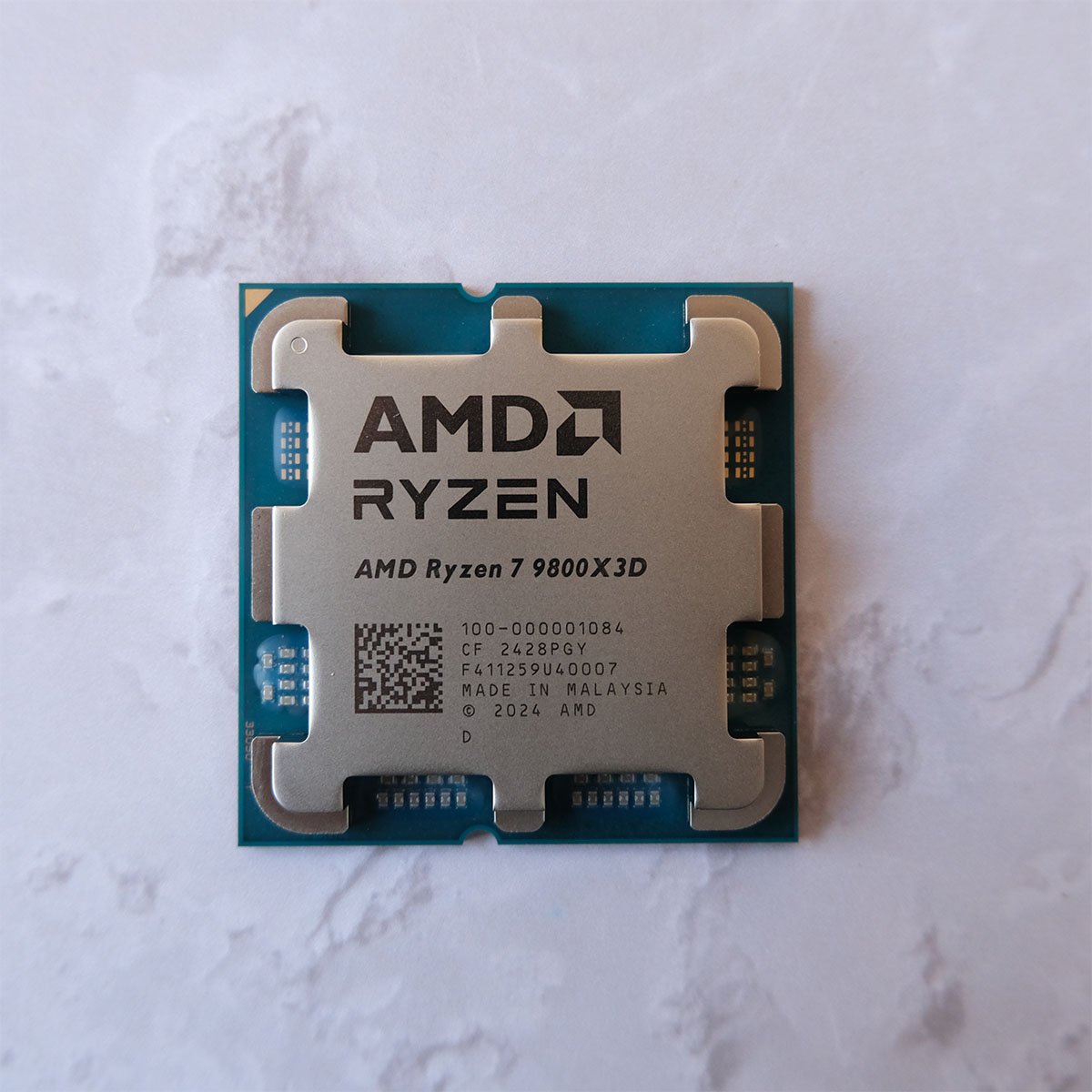
You see, Zen 5 cores produce plenty of heat running at full chat whereas the X3D cache does not. In previous models, positioning extra cache between cores and heatspreader stunted CPU-side frequency and voltage potential as cores couldn’t be cooled as well as AMD hoped for – 64MB of L3 was literally in the way. This is precisely why older X3D CPUs ran with very conservative frequencies and voltages that compromised regular performance.
Ryzen 7 9800X3D has a couple of tricks up its sleeve that previous generations do not.
Now, however, the CPU cores sit in the same area as on non-X3D offerings, meaning more power can be shunted their way without fear of overheating. It’s likely AMD thins the cores and cache to fit within a regular AM5 package.
Furthermore, perusing AMD’s supporting documents shows 7800X3D operates with a nominal 1.1V and 9800X3D with 1.28-1.31V, providing clear proof that the Ryzen team is comfortable in a higher energy utilisation CPU. So while, on paper, single-CCD processors all share a common 120W TDP, the truth is 5800X3D and 7800X3D never utilise most of it because of inherent design limitations.
Ryzen 7 9800X3D rights this faux pas and carries significantly higher base and boost clocks as a result. As you will see later, the processor maintains comfortably elevated frequencies in multi-core work. In the Ryzen 7 7800X3D I posed the question of where’s the frequency, AMD? Now I have my answer.
X3D Evolved
The second big news is related to the first. With more usable power available to cores and better heat dissipation to boot, AMD’s finally removed the pesky multiplier lock on X3D chips. Yes, you read that right; Ryzen 7 9800X3D matches up to regular chips by being overclockable. Hooray for enthusiasts. I’m comfortable in saying Ryzen 7 9800X3D is a gaming-focussed CPU done right.
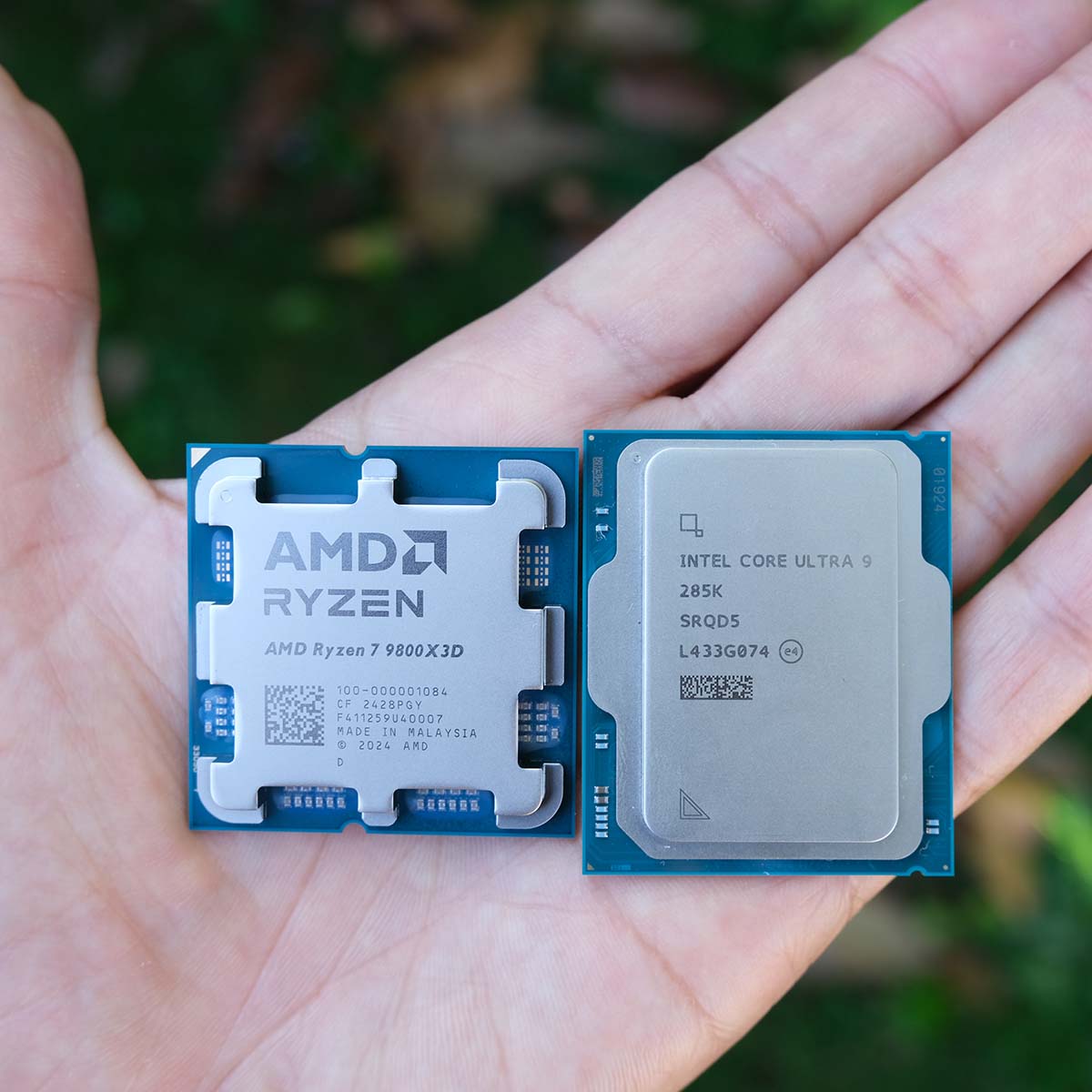
All of the new magic occurs under the familiar AM5 heatspreader; outwardly it resembles any AM5 chip. An inside joke for those in the know, there is no misprint on the packaging this time around!
Burrowed deep in the specs is the maximum memory speed that runs at DDR5-5600 on this chip and on 5800X3D but curiously only DDR5-5200 on 7800X3D. You probably won’t be running that frequency because said chips works best at DDR5-6000 in my experience. Those kits aren’t expensive, either, with a 32GB (2x16GB) available for under £100.
Ready for some numbers? I know I am.
Benchmarks
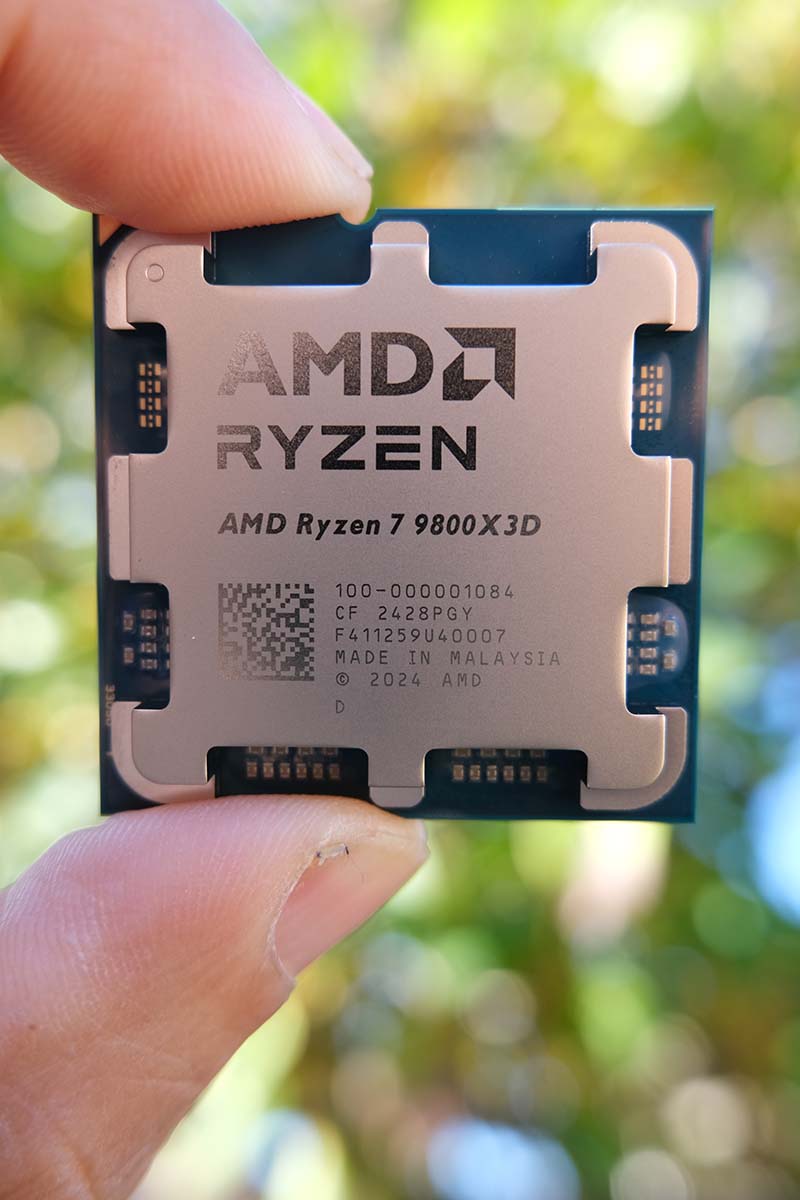
Ryzen 7 9800X3D CPU Test PC
Club386 carefully chooses each component in a test bench to best suit the review at hand. When you view our benchmarks, you’re not just getting an opinion, but the results of rigorous testing carried out using hardware we trust.
Shop Club386 test platform components:
Motherboard: MSI MEG X670E ACE
Cooler: Arctic Liquid Freezer III
GPU: Zotac GeForce RTX 4090
Memory: 64GB Kingston Fury Beast DDR5
Storage: 2TB WD_Black SN850X NVMe SSD
PSU: be quiet! Dark Power Pro 13 1,300W
Chassis: Fractal Design Torrent Grey
Prefacing productivity results and providing necessary context, it makes sense to list each chip’s all-core speed when running multi-core Cinebench 2024 for 10 minutes.
| Chip | Frequency | TDP |
|---|---|---|
| AMD Ryzen 9 9950X | 5.001GHz | 170W |
| AMD Ryzen 9 9900X | 5.107GHz | 120W |
| AMD Ryzen 7 9800X3D | 5.220GHz | 120W |
| AMD Ryzen 9 7950X | 5.050GHz | 170W |
| AMD Ryzen 9 7950X3D | 4.552GHz | 120W |
| AMD Ryzen 7 9700X | 4.634GHz | 65W |
| AMD Ryzen 7 7700X | 5.285GHz | 105W |
| AMD Ryzen 5 9600X | 5.090GHz | 65W |
| AMD Ryzen 5 7600X | 5.358GHz | 105W |
| AMD Ryzen 7 7800X3D | 4.840GHz | 120W |
| Intel Core Ultra 9 285K* | 4.678GHz | 250W |
| Intel Core i9-14900K* | 4.712GHz | 253W |
| Intel Core i7-14700K* | 4.523GHz | 253W |
| Intel Core i5-14600K* | 4.453GHz | 181W |
* Intel P-core frequencies listed
Understanding frequency lays appropriate foundation for what you are about to see, and as promised, 9800X3D has the ability to take full advantage of its heightened headroom, hitting over 5.2GHz in my PC.
App Performance
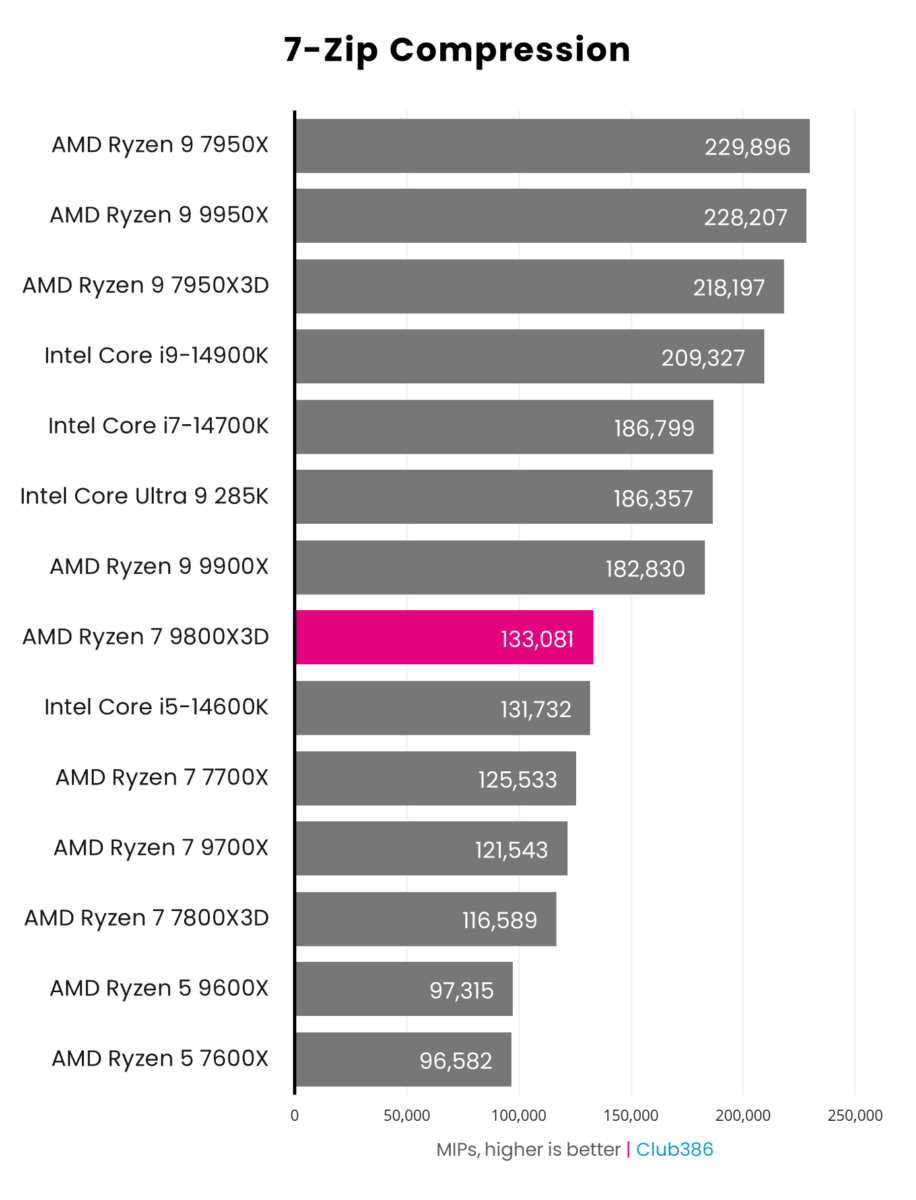
Using more of the 120W TDP is crucial for enhancing 8C16T performance in multi-core applications. I’m seeing 9800X3D outpace regular 9700X because its 65W default cap also hinders the very frequency that helps here.
Comparing like for like, a nice 14% boost over Ryzen 7 7800X3D to kick off with.
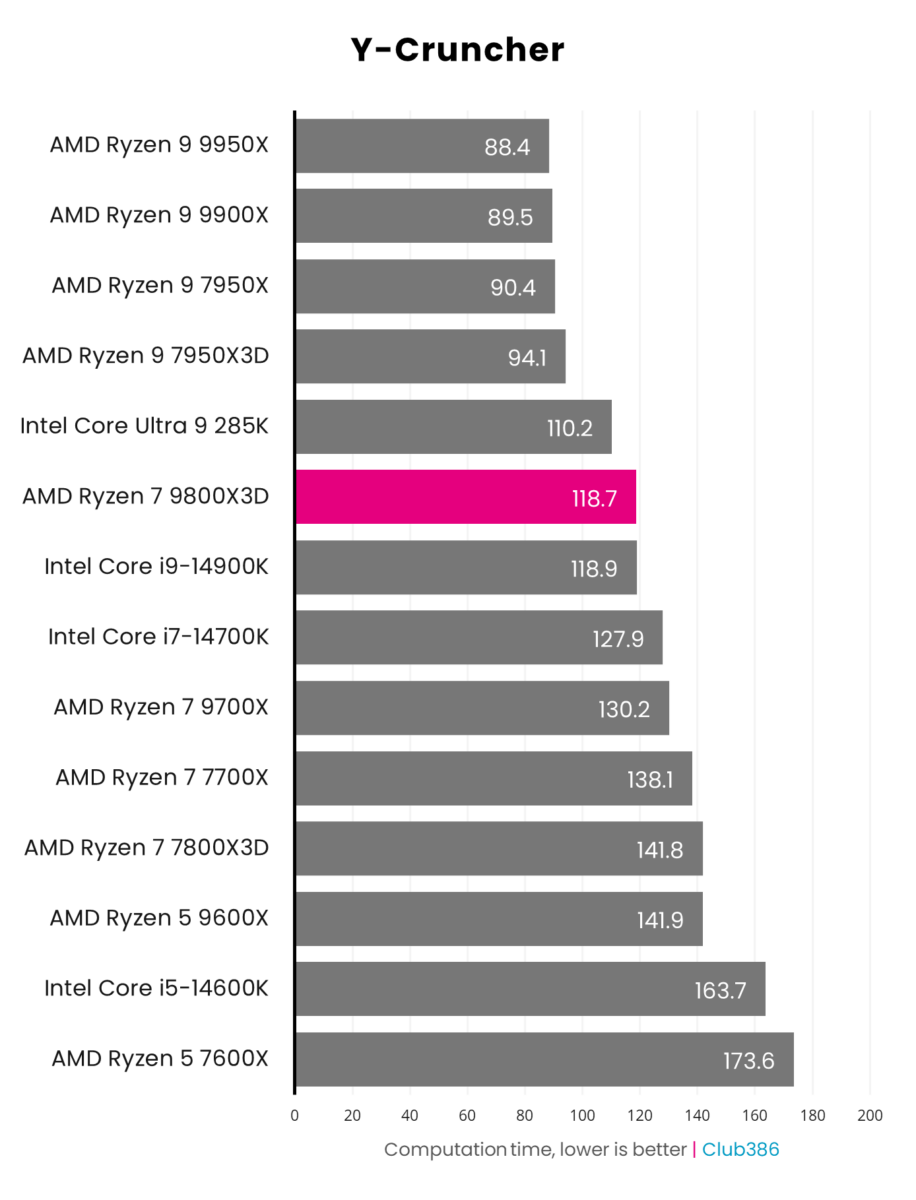
Y-cruncher is more indicative of well-threaded applications that love the trifecta of cores, threads, and high frequencies. Ryzen 7 7800X3D is almost 20% slower, while even Intel’s Core i9-14900K cannot beat out the latest single-CCD X3D part.
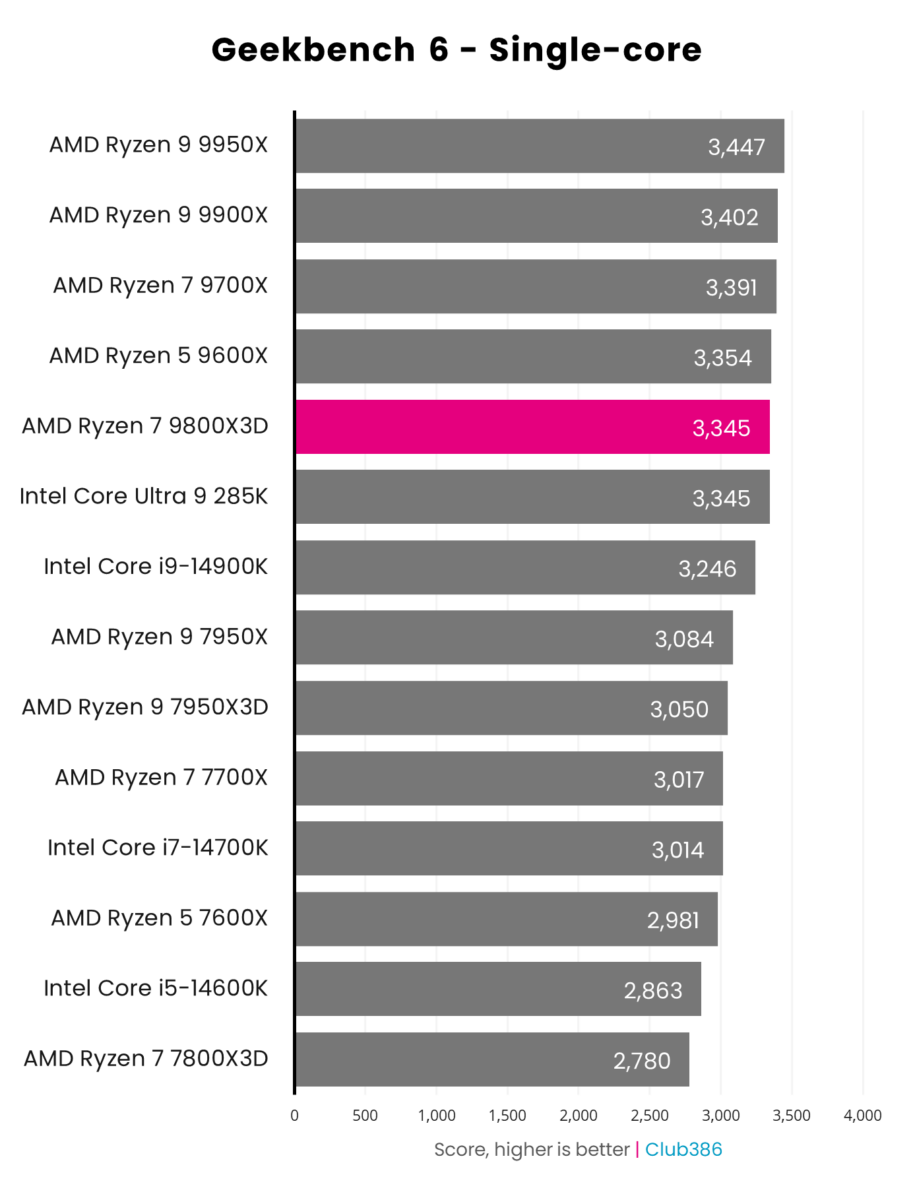
AMD’s Zen 5 architecture brings with it heightened IPC. Another 20% faster than the same chip of the previous generation. Get used to it.
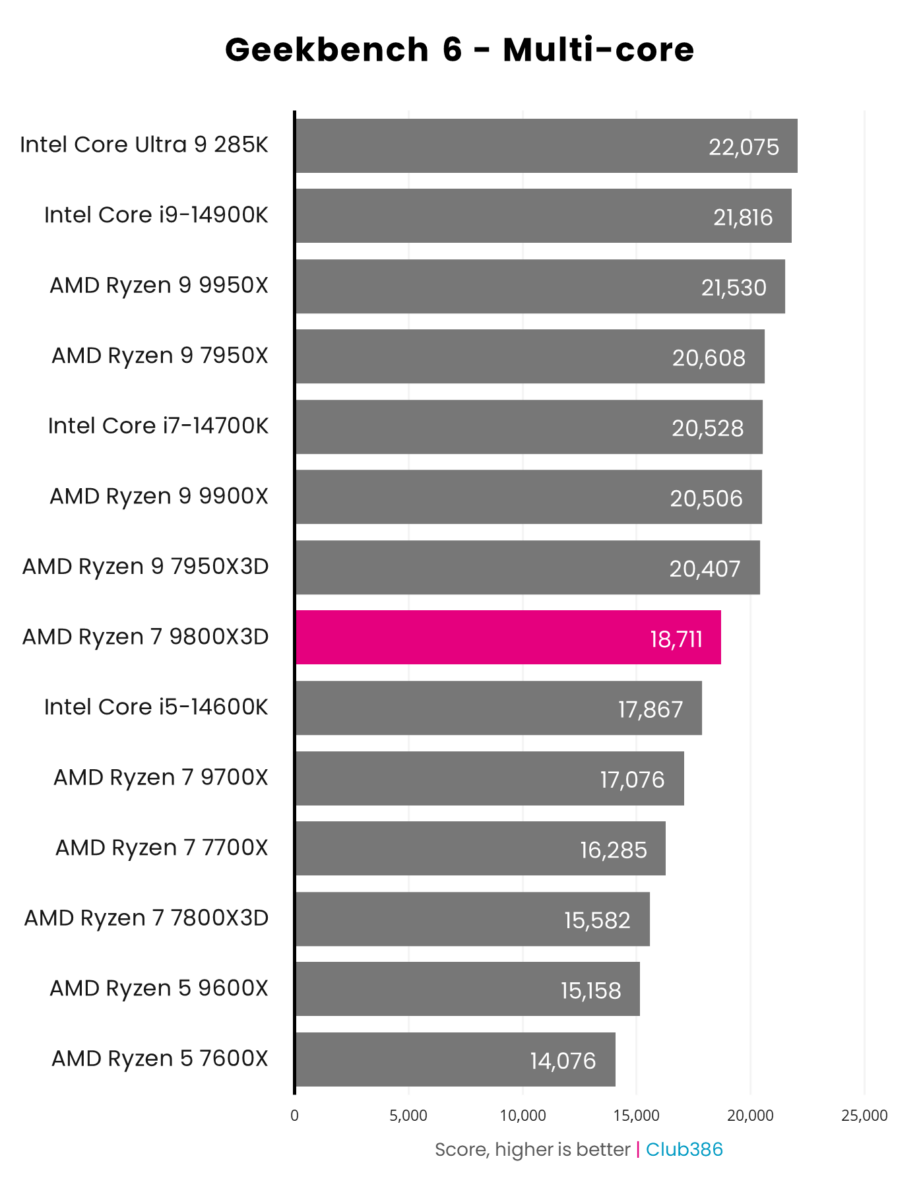
Anything around 20,000 marks is good enough to provide a very smooth experience when running numerous common applications concurrently.
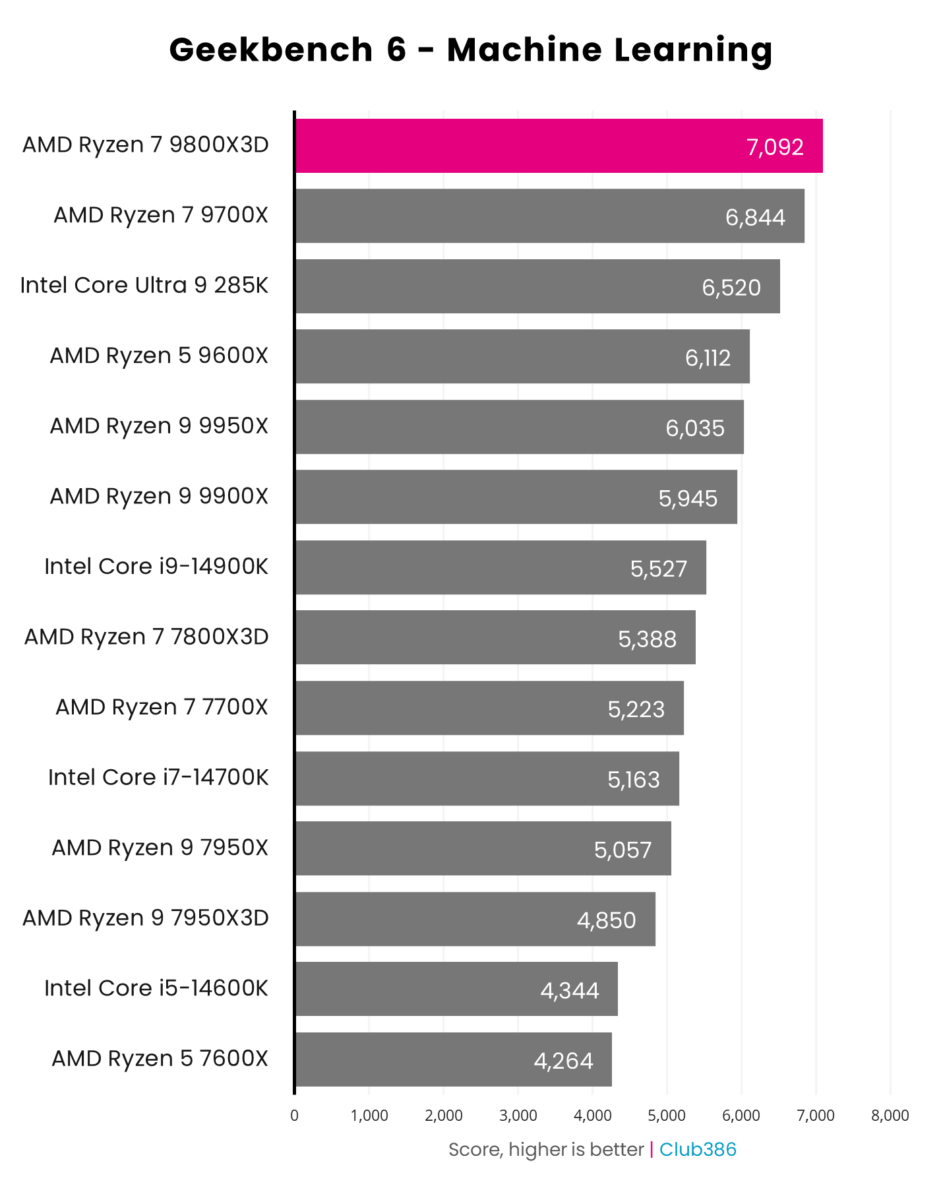
What do you know, the latest X3D offering tops the charts.
Content Creation
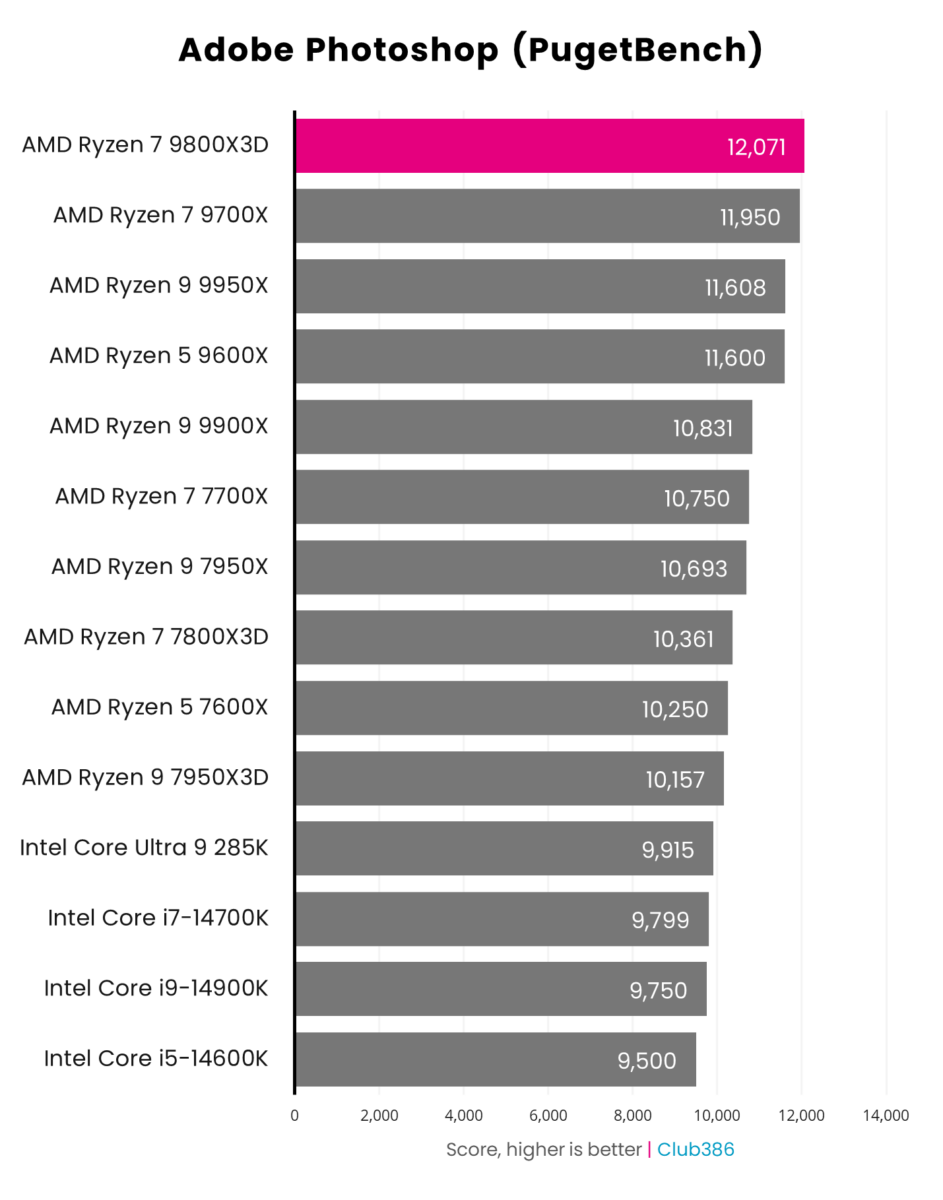
More proof that extra L3 cache helps in popular applications as well as games.
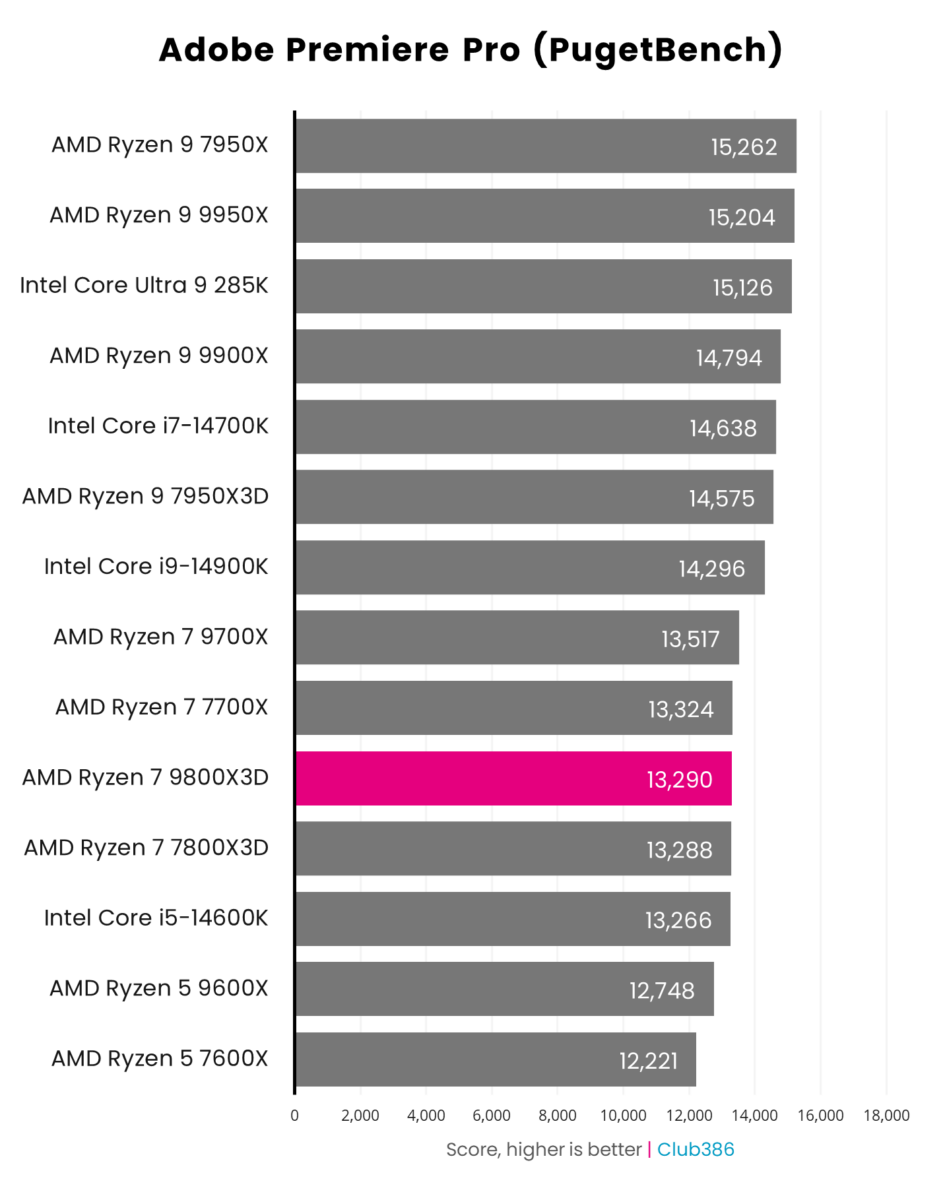
Some applications like more L3 cache, others don’t care as much. PugetBench’s Premiere Pro test falls in the latter camp.
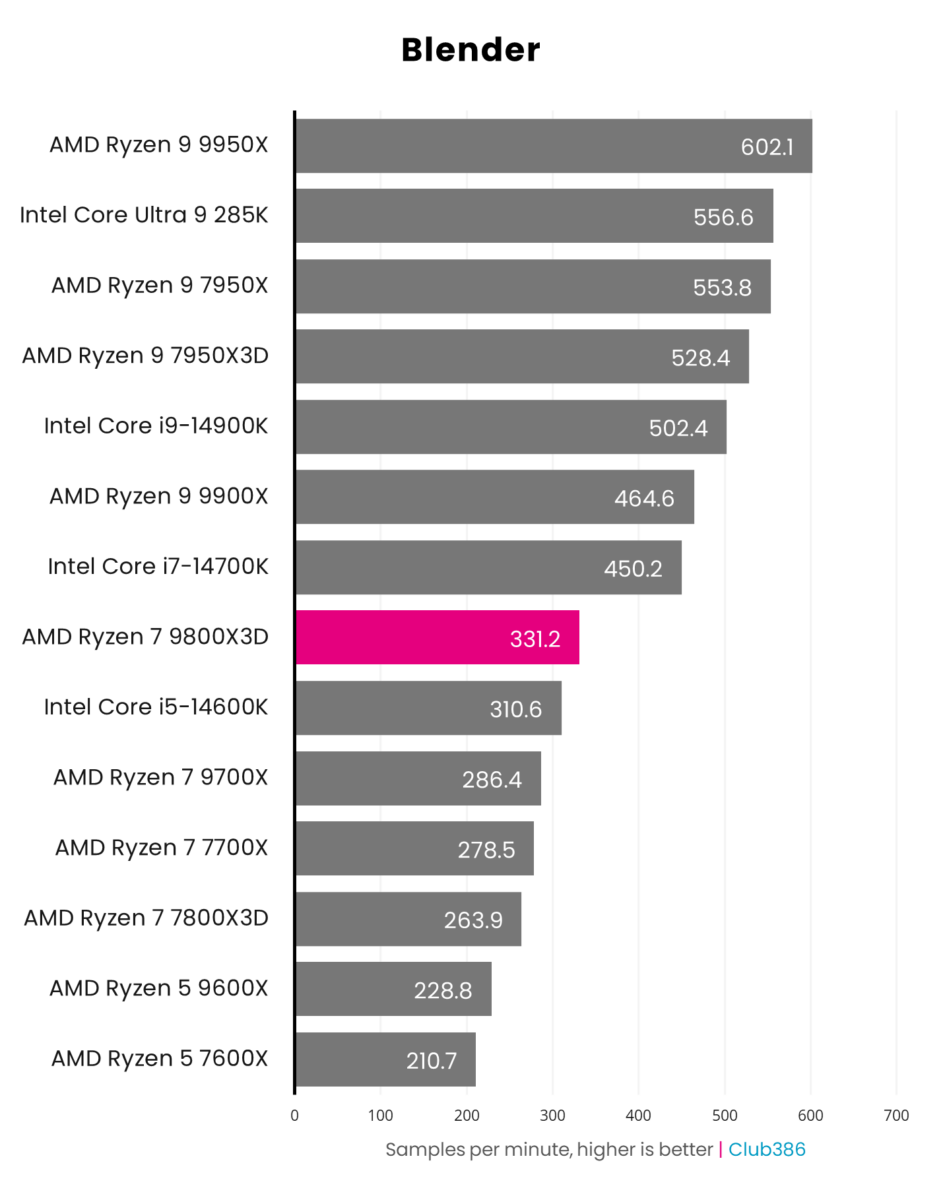
Here’s where more cores do matter. Nevertheless, you’re looking at Core i5-14600K kind of performance. This time around, the gap between generational single-CCD X3Ds is a considerable 25.5%.
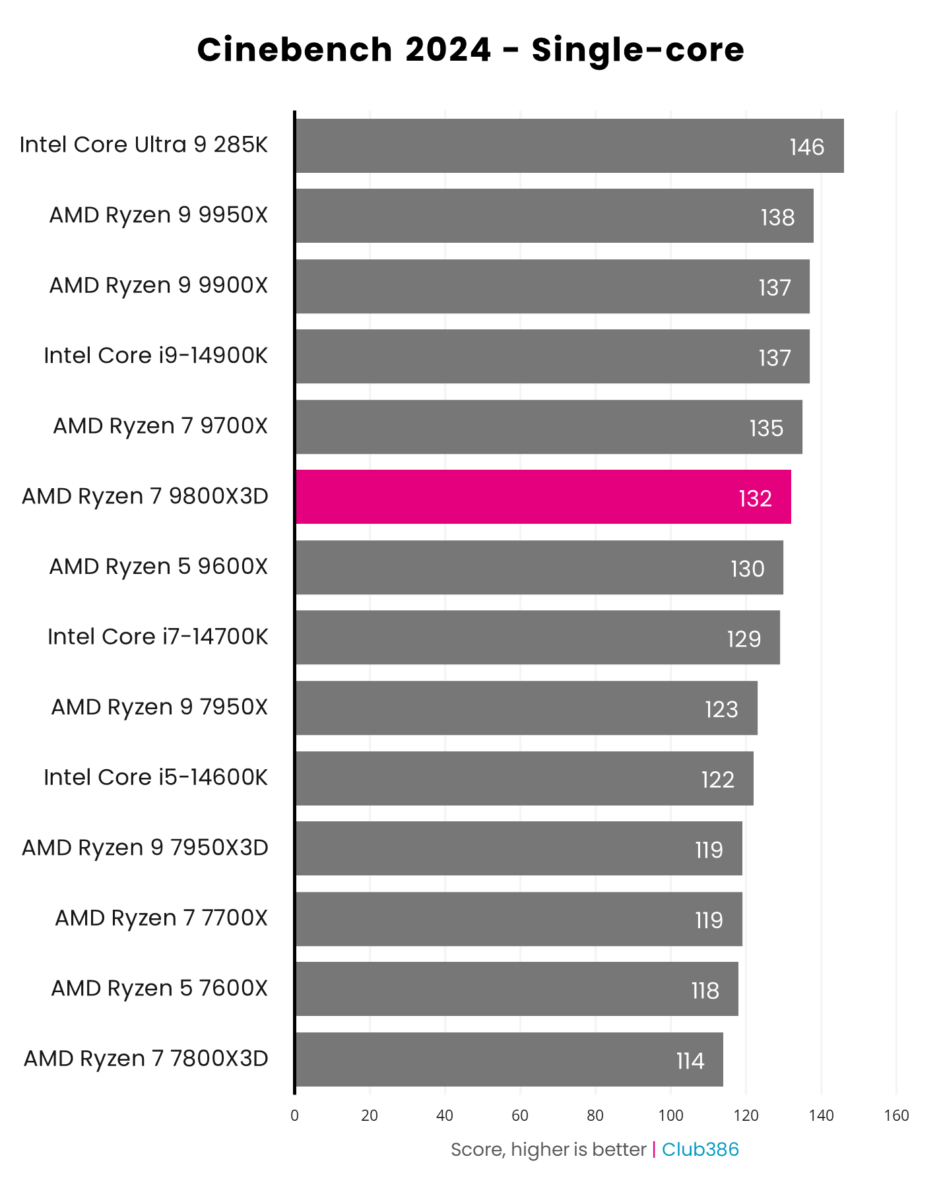
Zen 5? Check. Great single-core performance? Check.
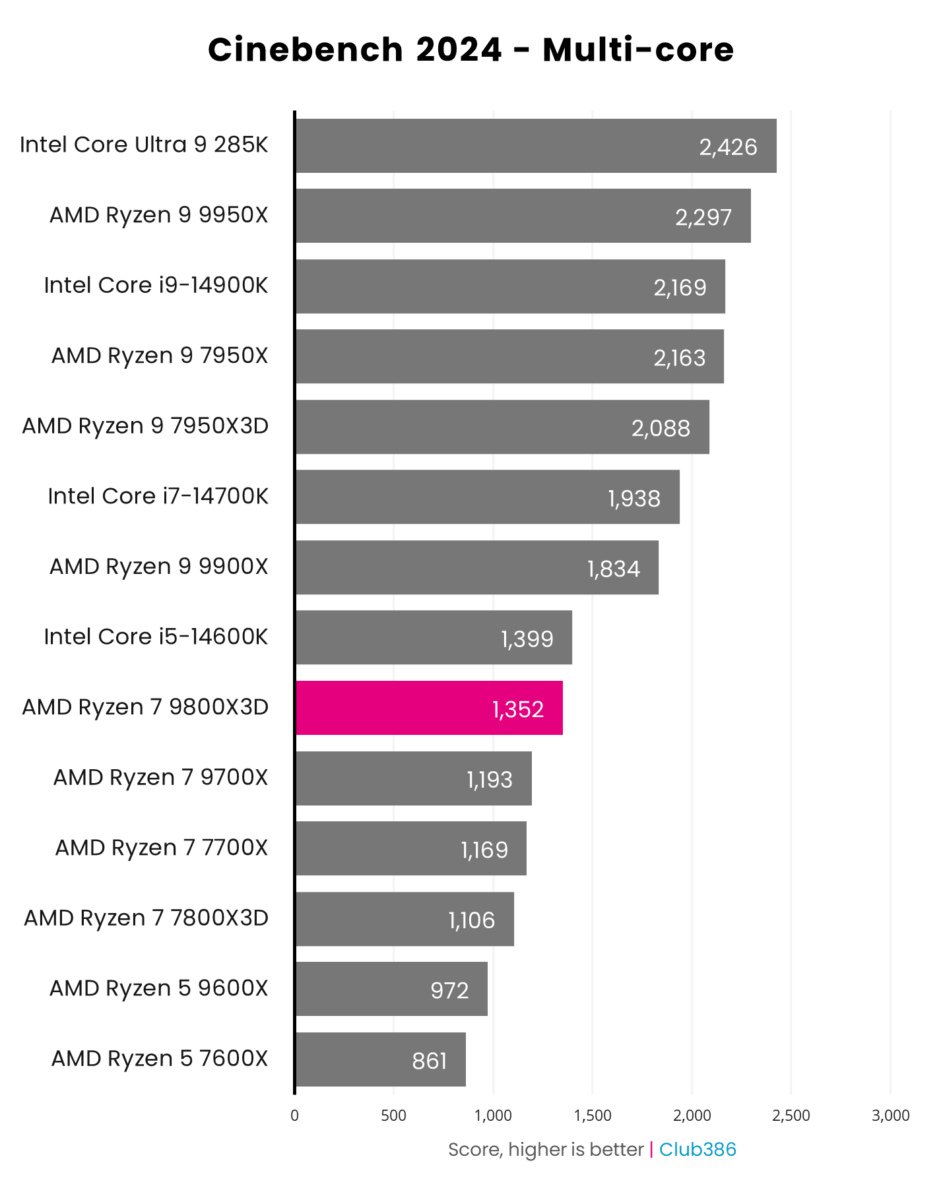
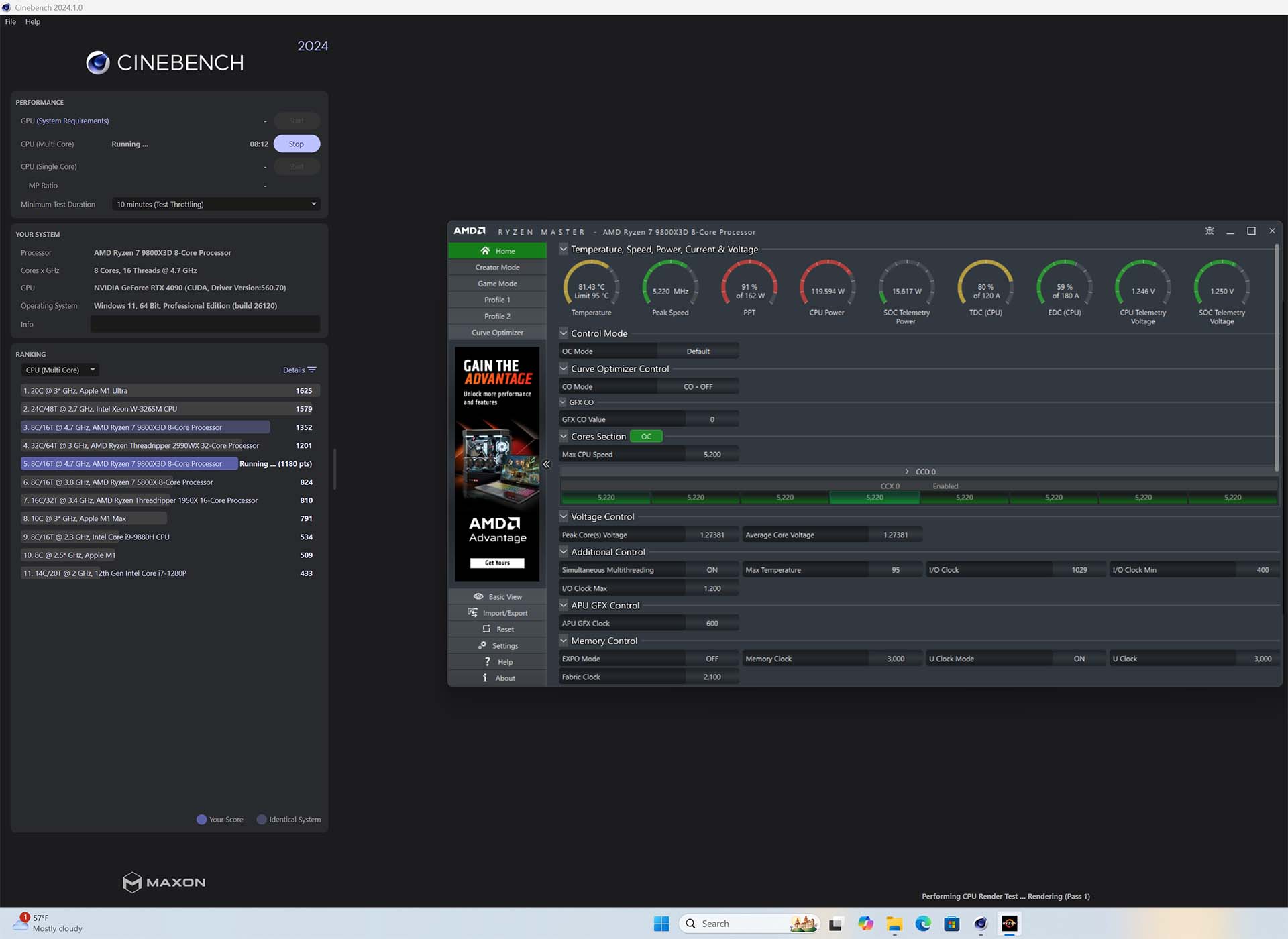
This is precisely how an 8C16T Ryzen ought to behave. No more leaving performance on the table because of concerns with how hot CPU cores become when sandwiching X3D cache.
I can prove this by looking at the power consumption during all-core Cinebench 2024 load. Ryzen 7 9800X3D gobbles up the entire 120W CPU power (see above) and gets very close to the 162W PPT limit. Putting it another way, the X3D cache isn’t stopping the CPU cores from doing their thing.
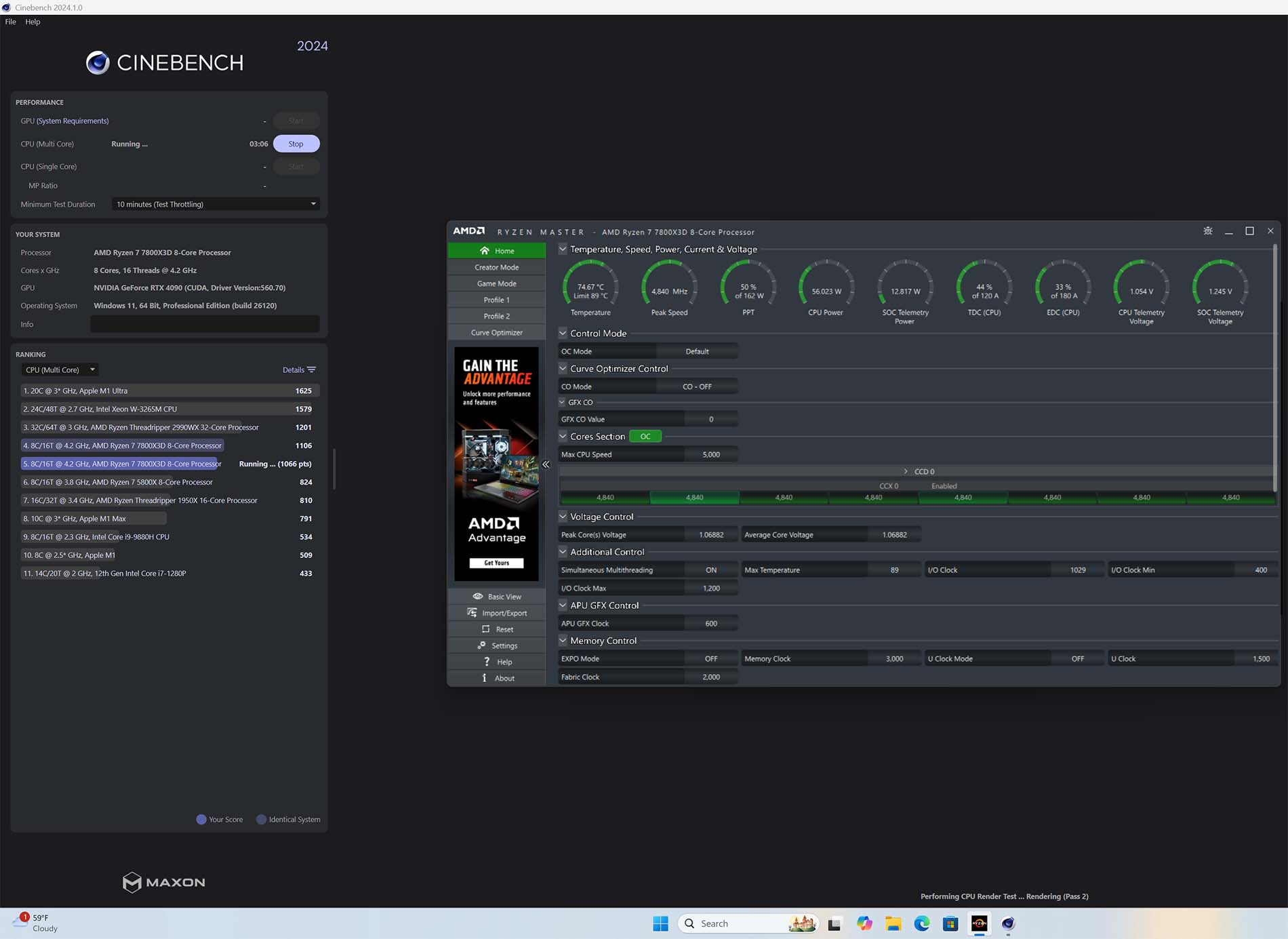
Here’s exactly the same setup but with Ryzen 7 7800X3D now in the socket. Notice how AMD refuses to allow CPU cores to pull anywhere close to the presumed 120W, forcing frequency and voltage down because last-generation X3D cache is harming thermals. Here’s clear evidence of the poor design I alluded to above. And the very fact that 7800X3D is multiplier locked doesn’t help on the performance front.
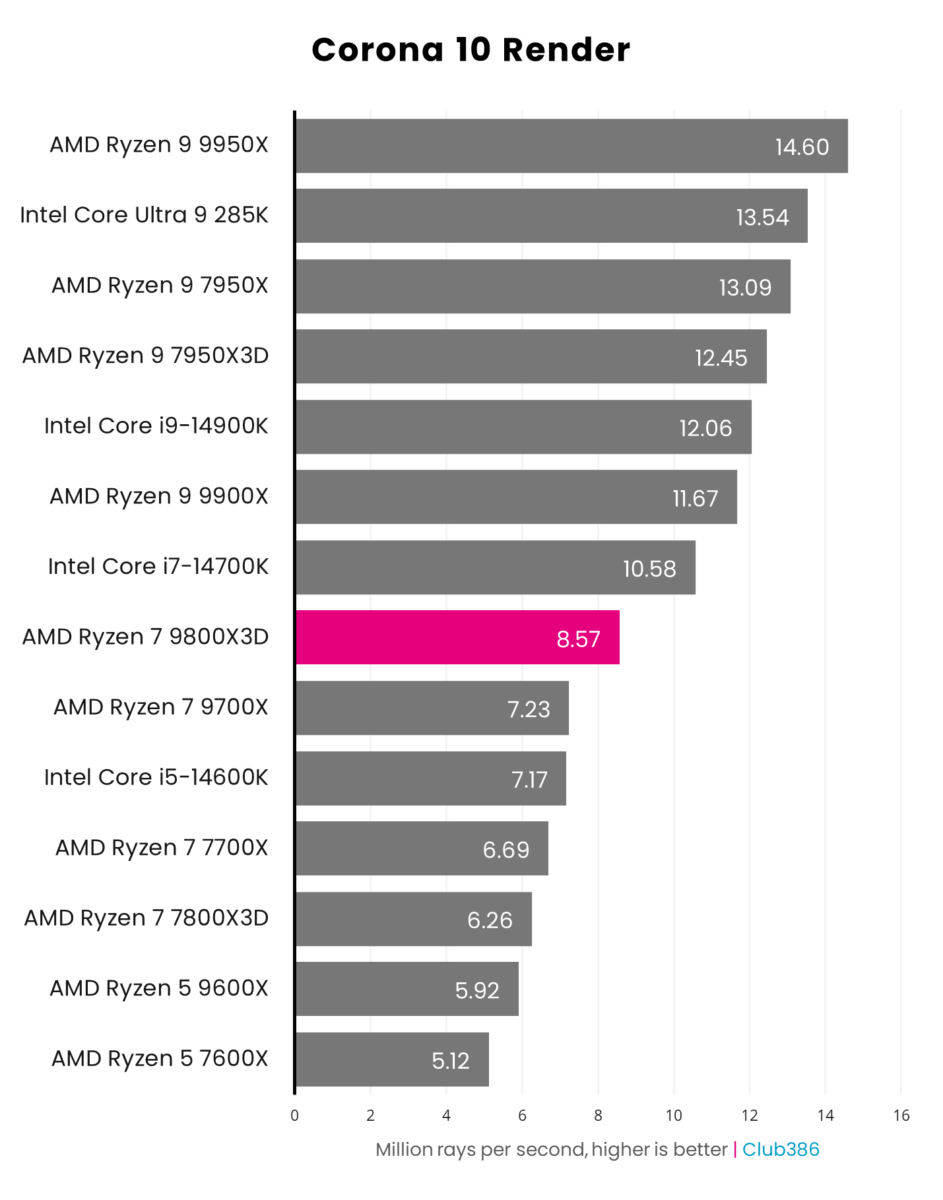
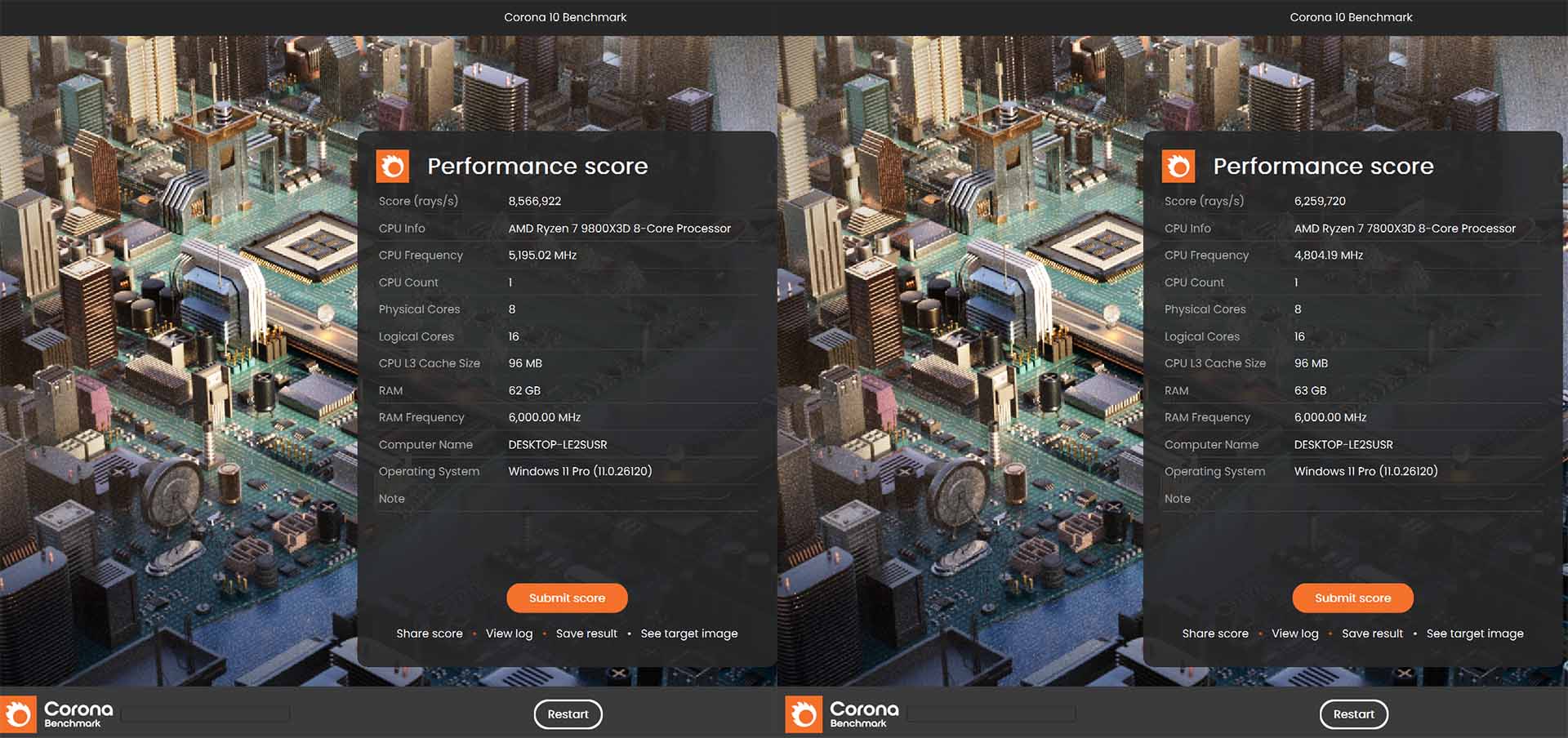
Higher frequency meets a better architecture, explaining why Ryzen 7 9800X3D is a much better rendering chip than Ryzen 7 7800X3D.
Memory
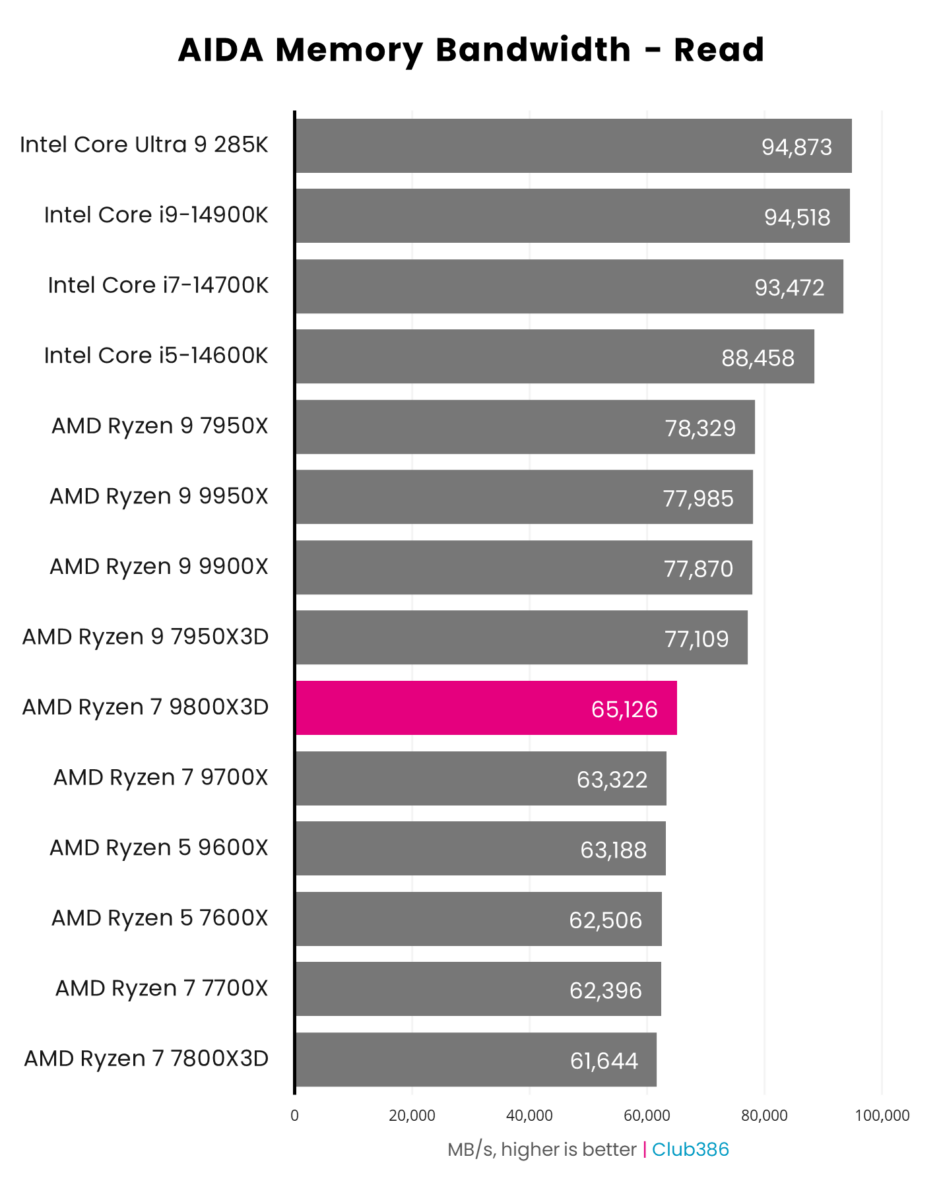
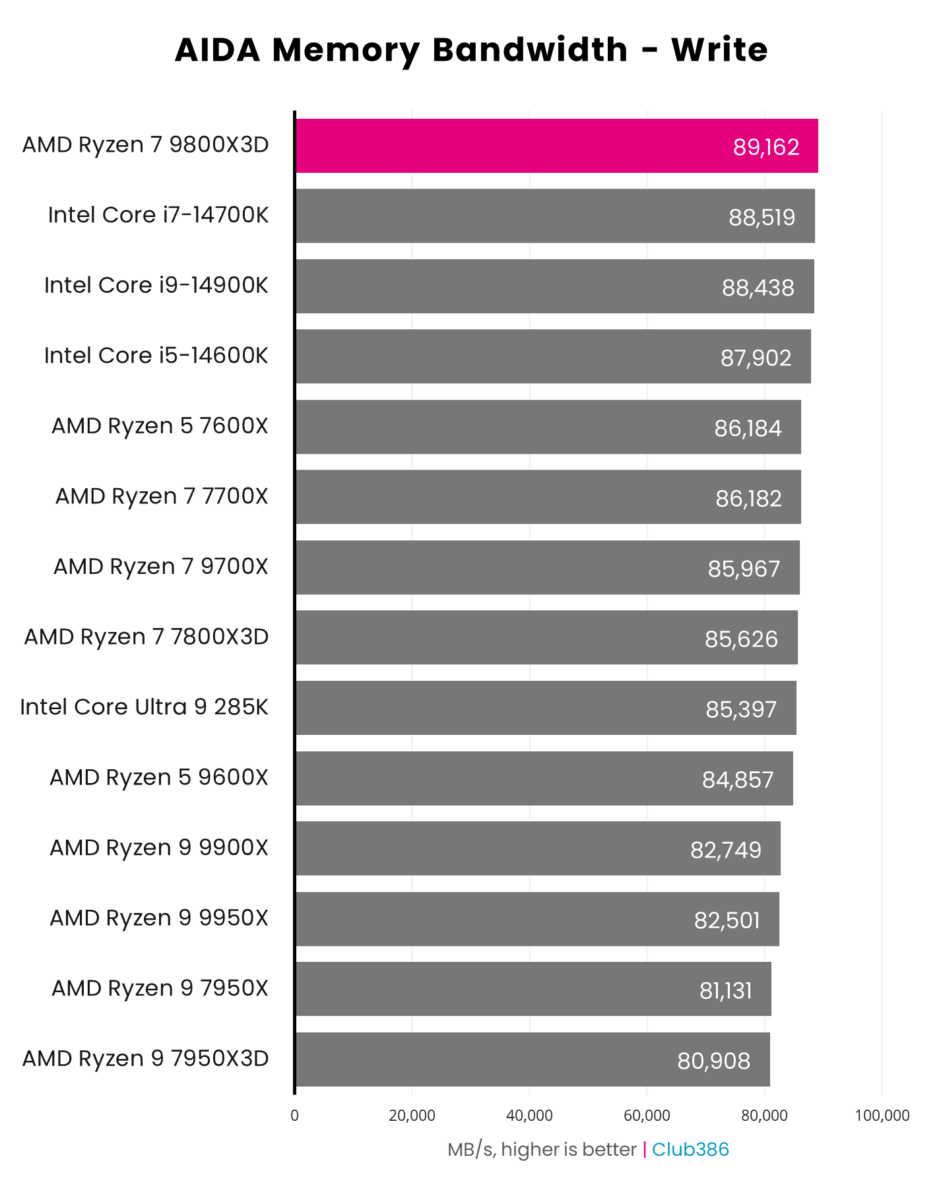
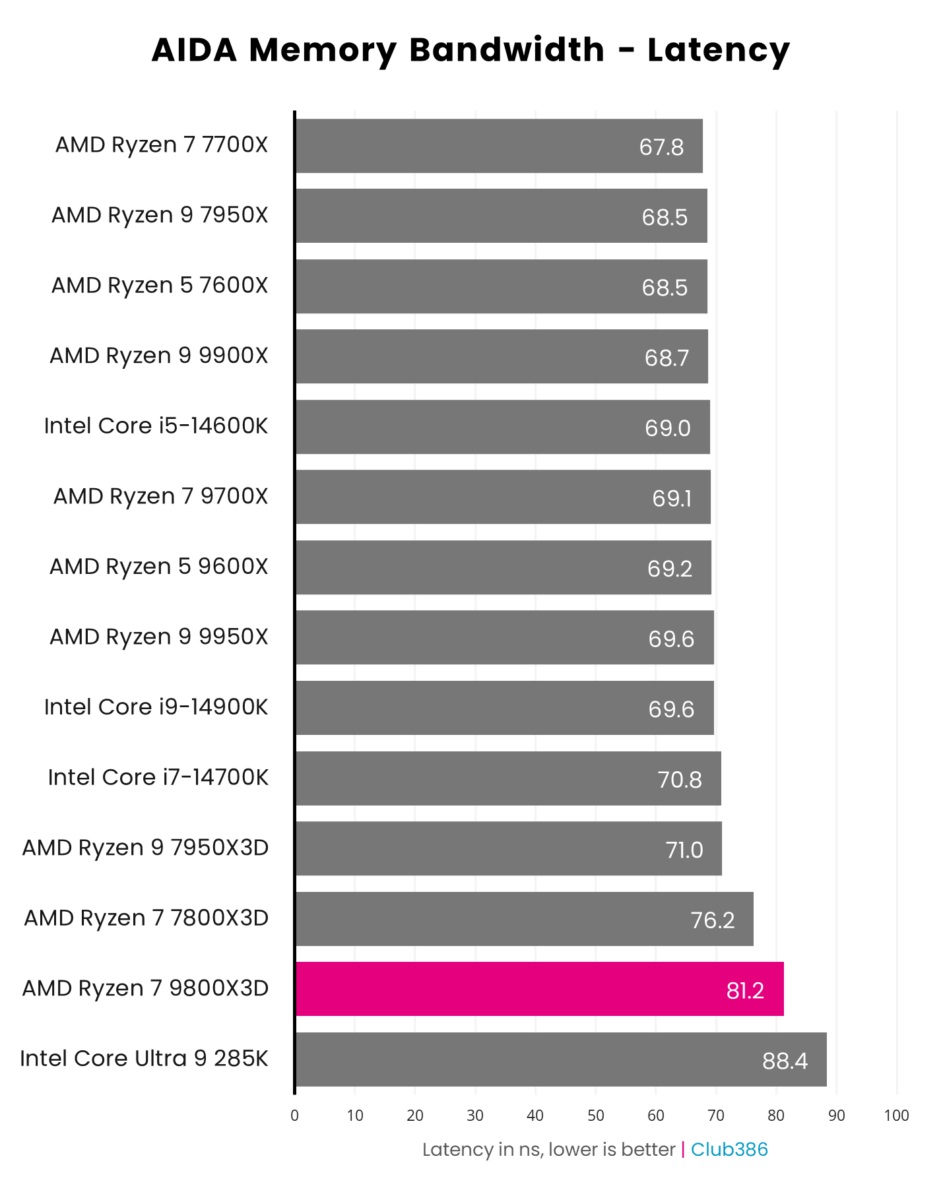
The latest version of AIDA paints X3D chips poorly with respect to latency. There’s nothing to worry about here, mind, though the increase compared to non-X3D CPUs can be explained by how cores communicate with main DRAM; it seems as if AMD runs accesses through the L3 chiplet.
Gaming
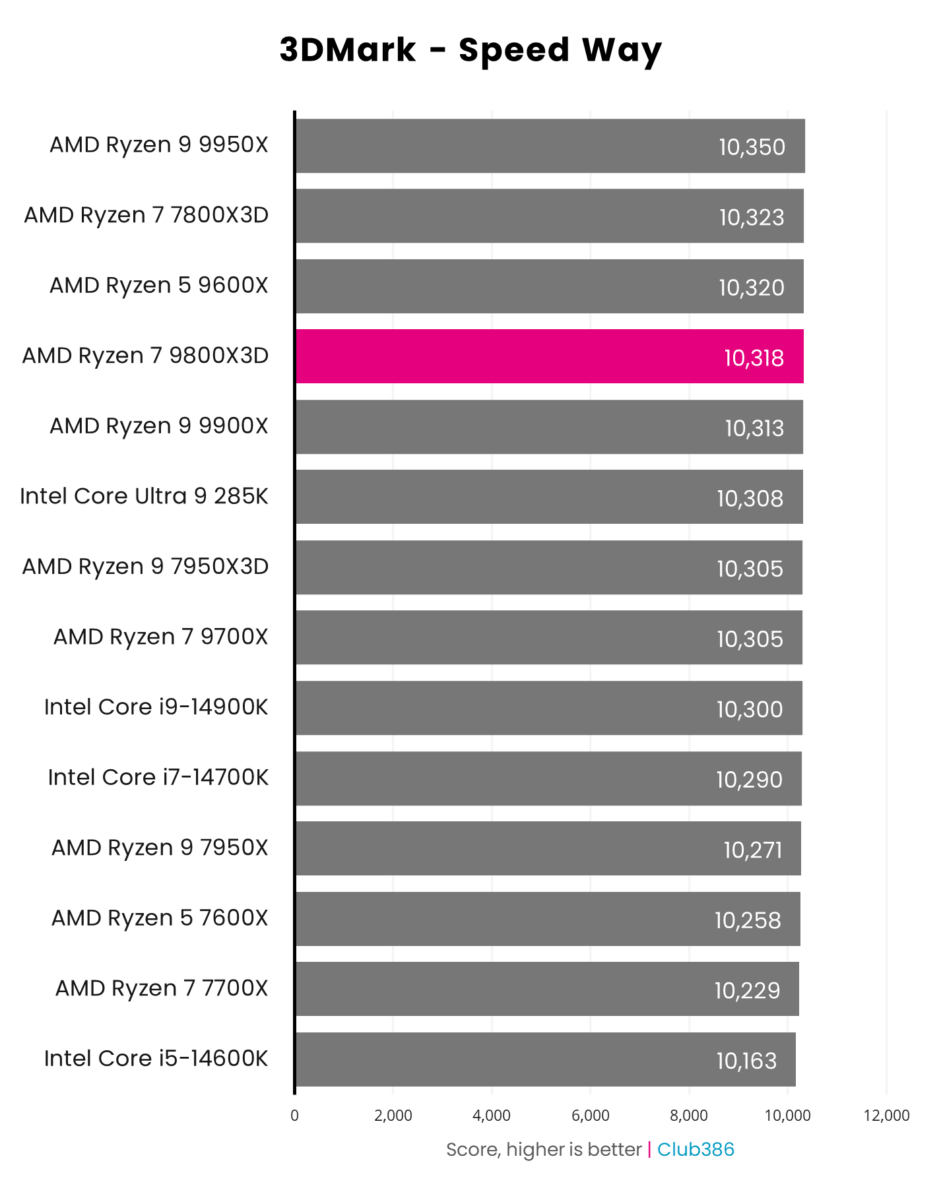
I bet you didn’t come to read a Ryzen X3D review for how it performs in everyday applications. First off the bat, the GPU-limited 3DMark Speed Way shows no meaningful difference between any CPU.
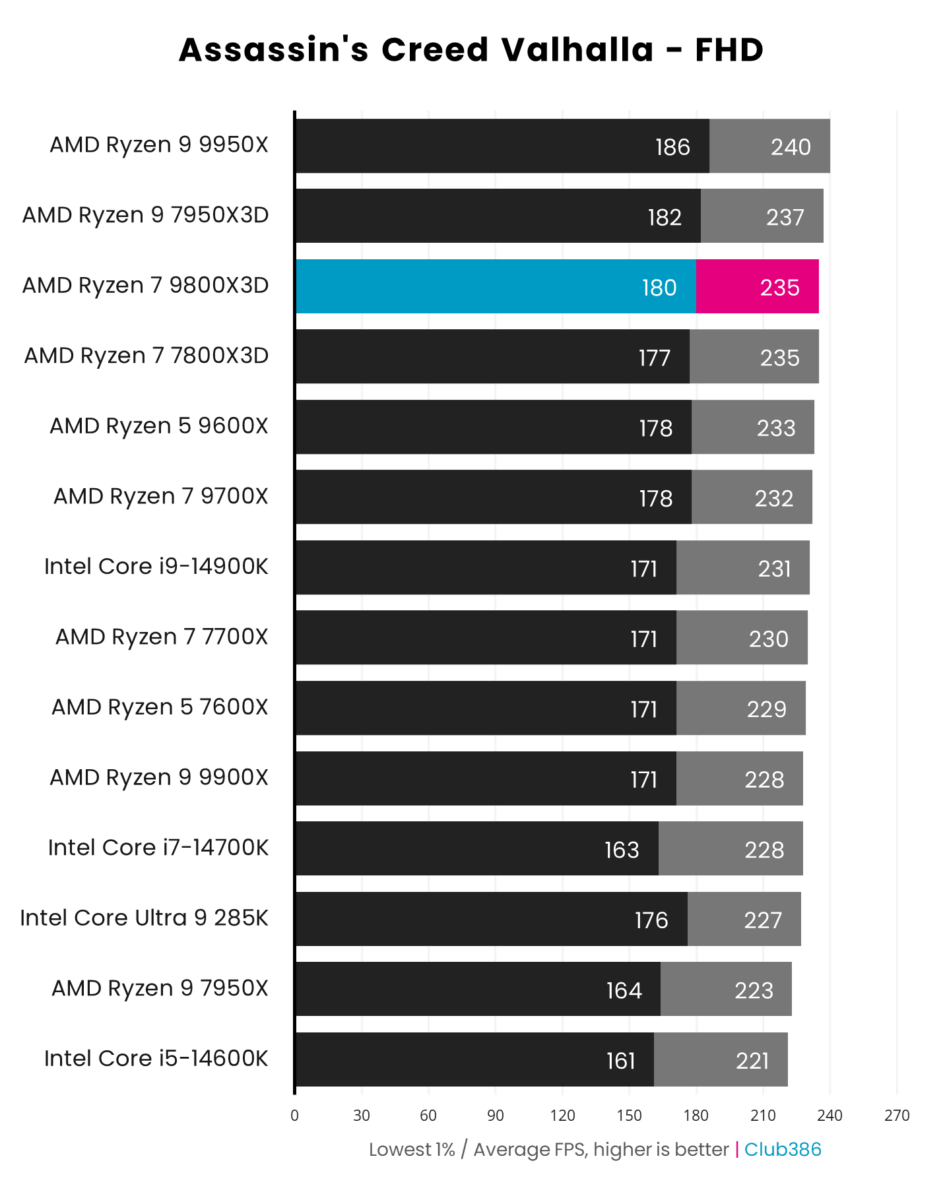
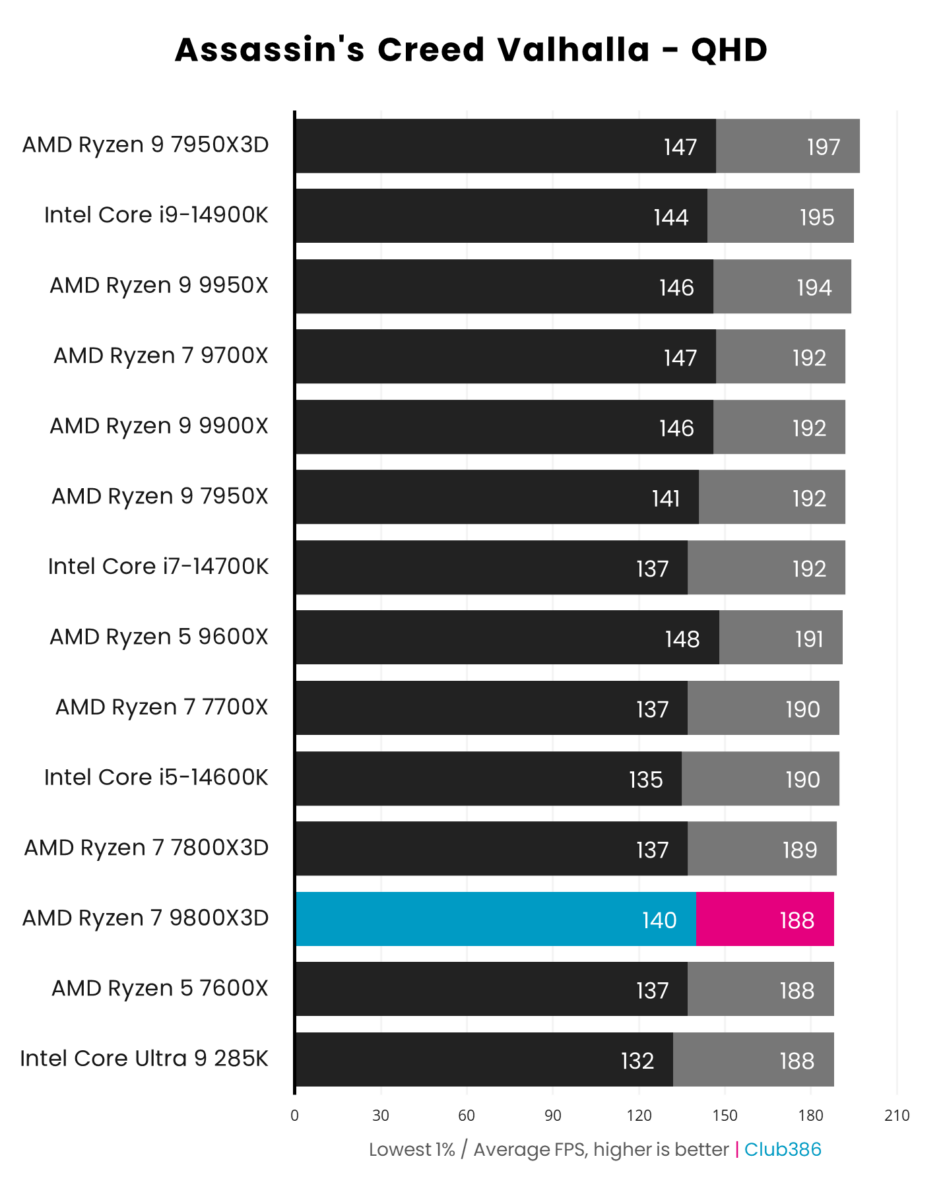
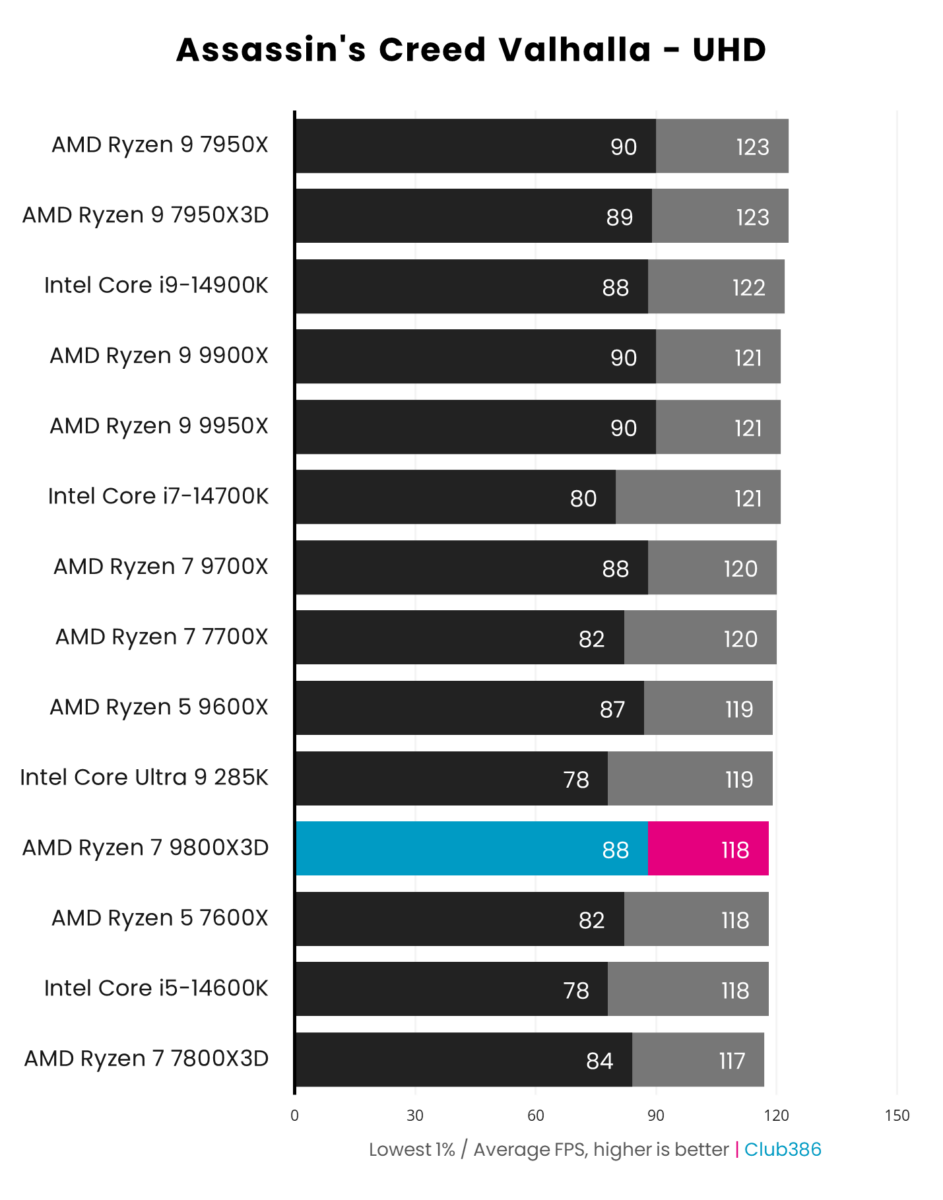
A solid if unspectacular start in gaming. The value of X3D cache is very much dependent on the game engine. Some will love it; others will be oblivious. Assassin’s Creed Valhalla toes the latter line.
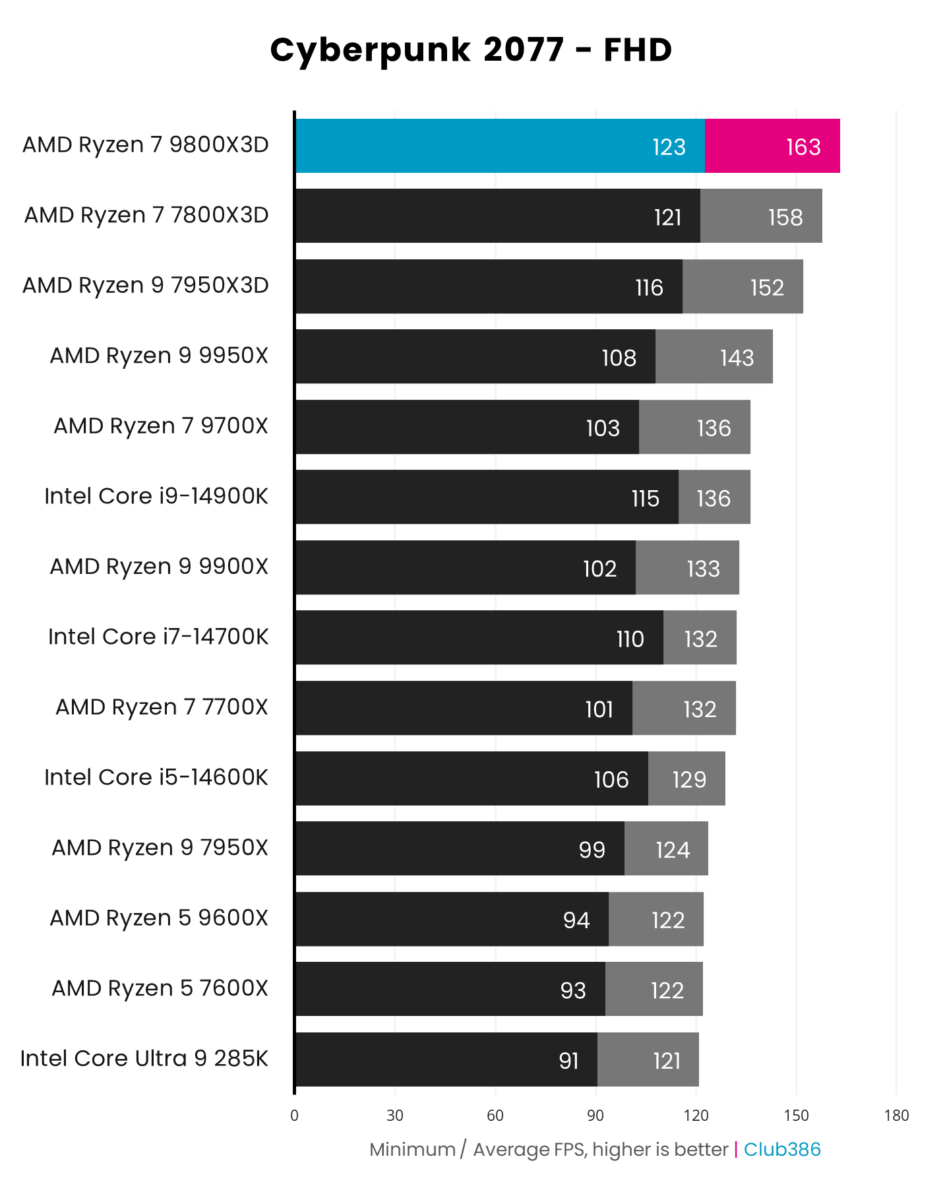
That’s more like it, Ryzen 7 9800X3D. Putting a massive 42fps into an Intel Core Ultra 9 285K at FHD, there is only one king of the Night City hill.
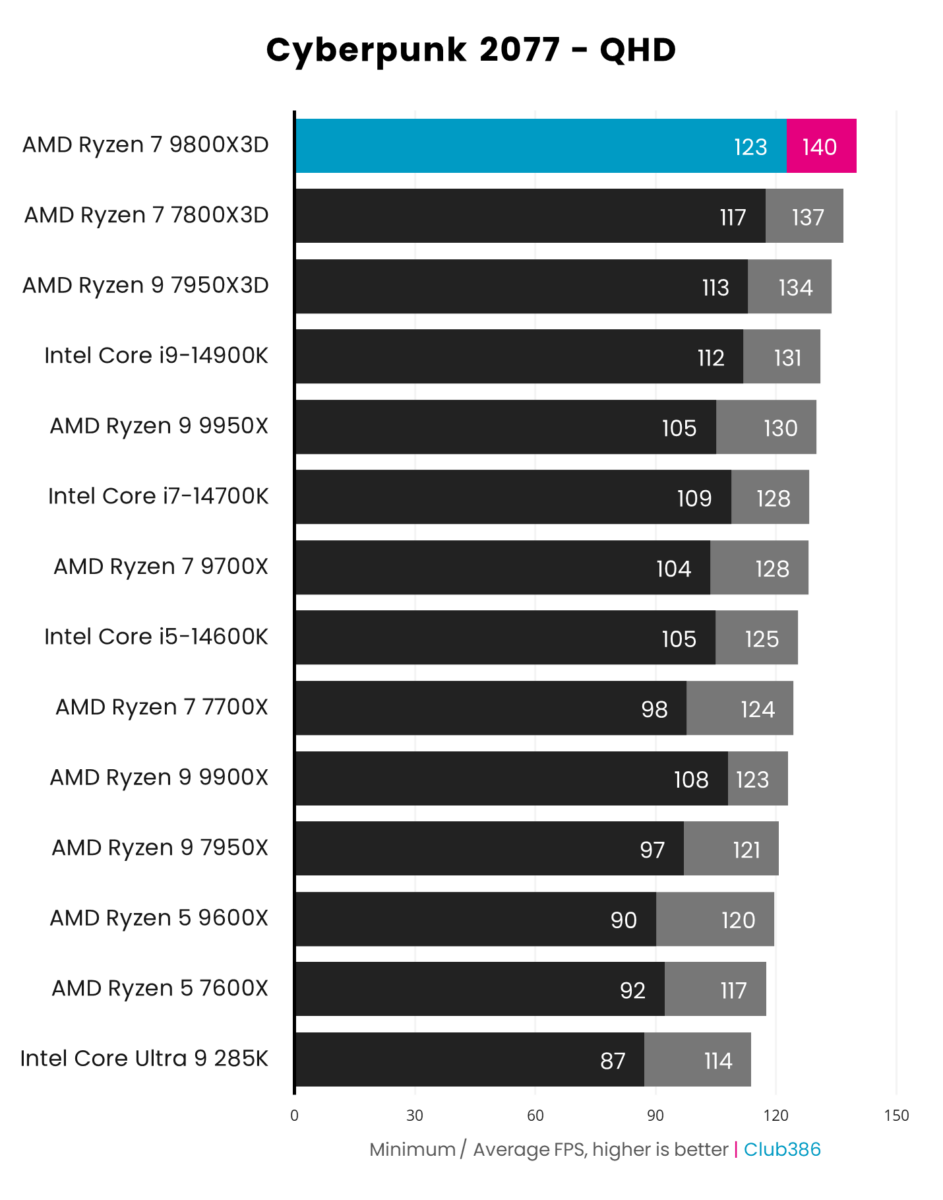
X3D’s usefulness extends to QHD, as well. Smacking the latest Intel chips around, there’s a significant 26fps difference between the pair.
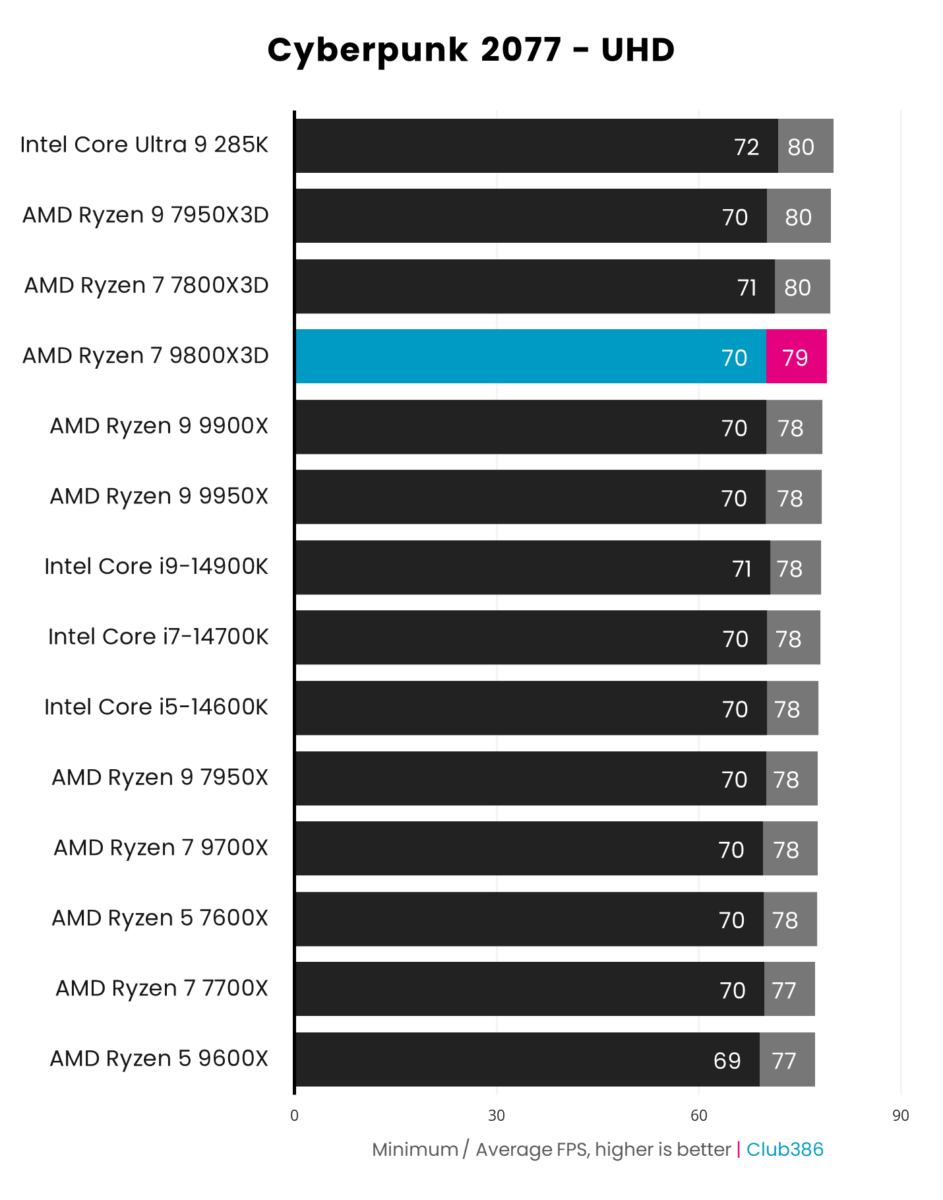
Everything simmers down at UHD, which is to be expected as even a mighty RTX 4090 becomes the bottleneck.
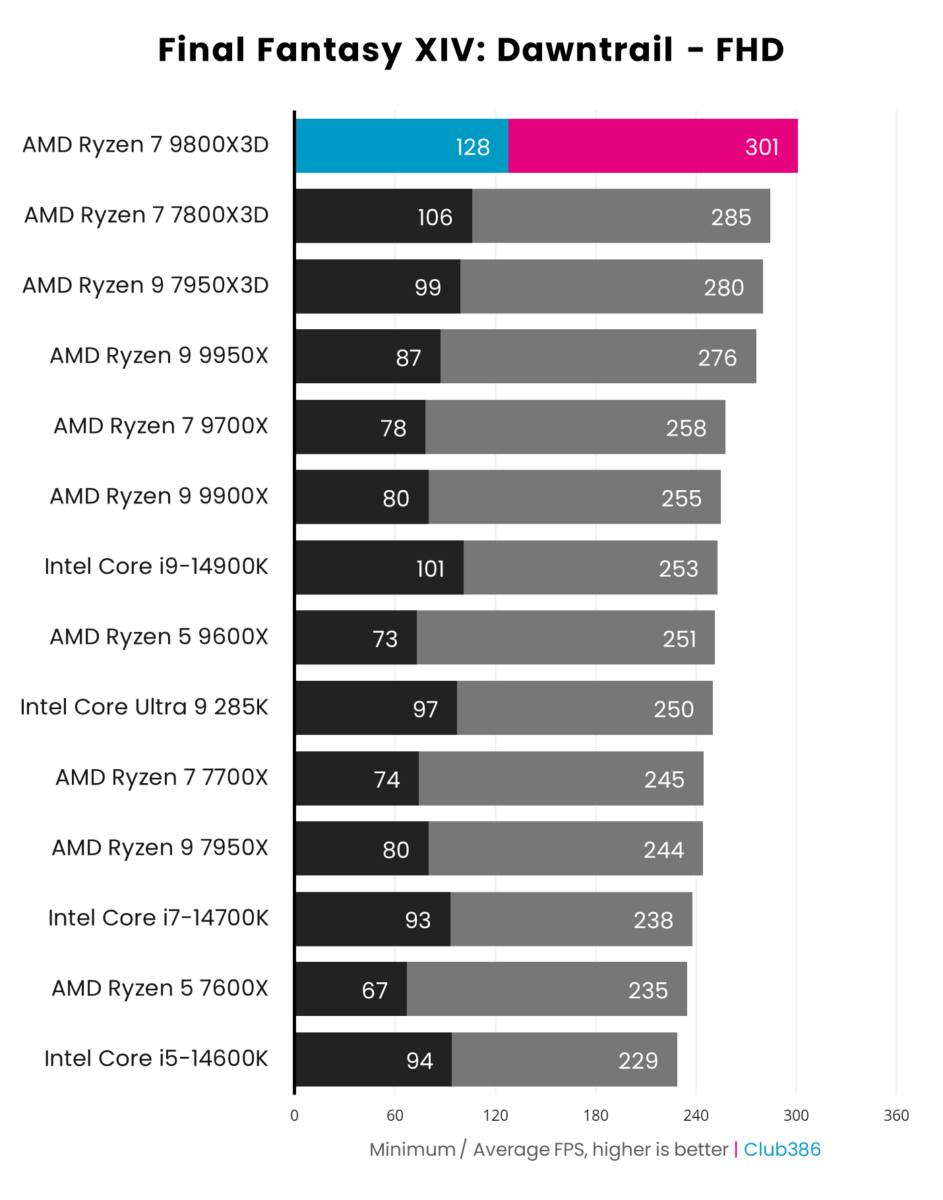
The very first time I’ve seen over 300fps in Dawntrail, AMD’s X3D cache loves this game. 9800X3D hands 285K a 51fps beating.
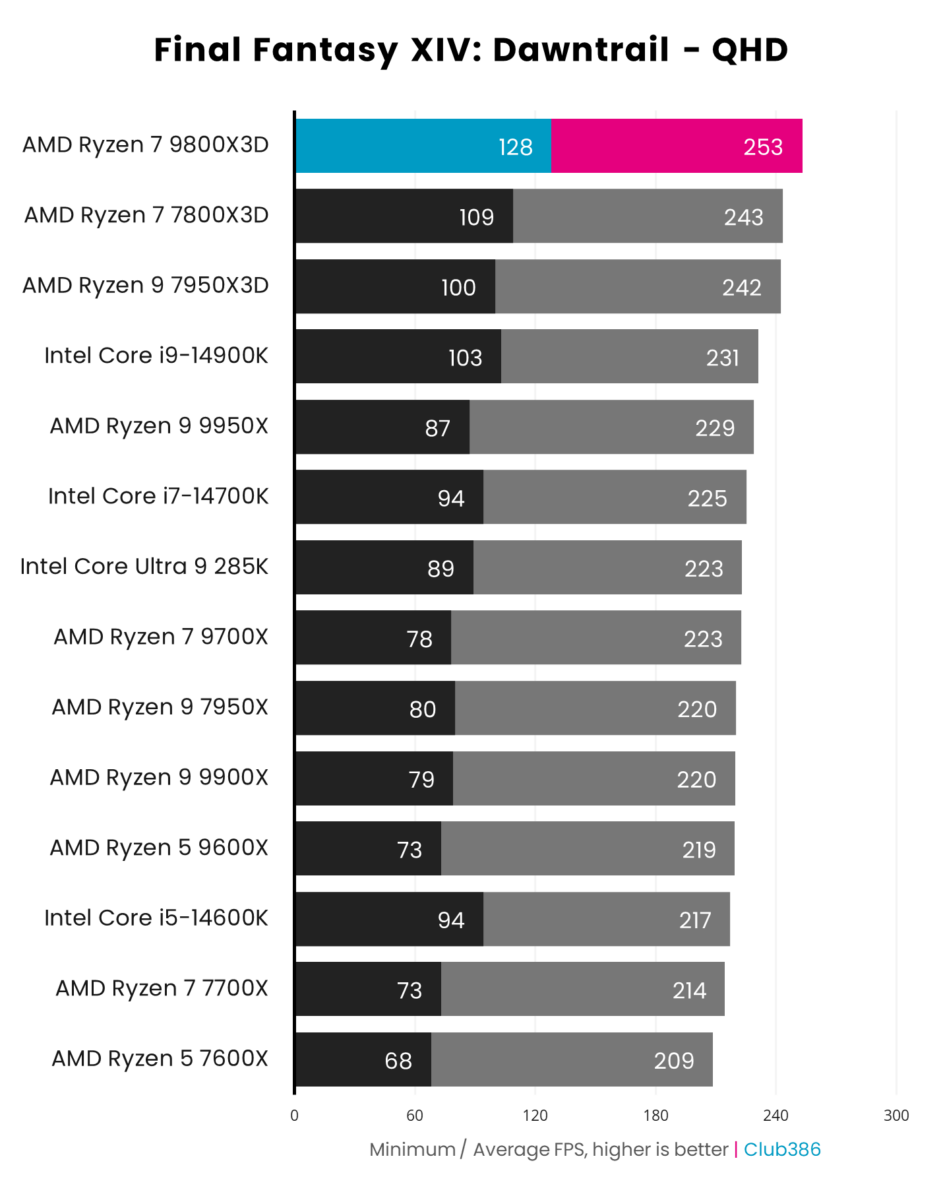
The review chip is actually faster at QHD than, say, 285K is at FHD. That’s a bitter pill to swallow for Team Blue.
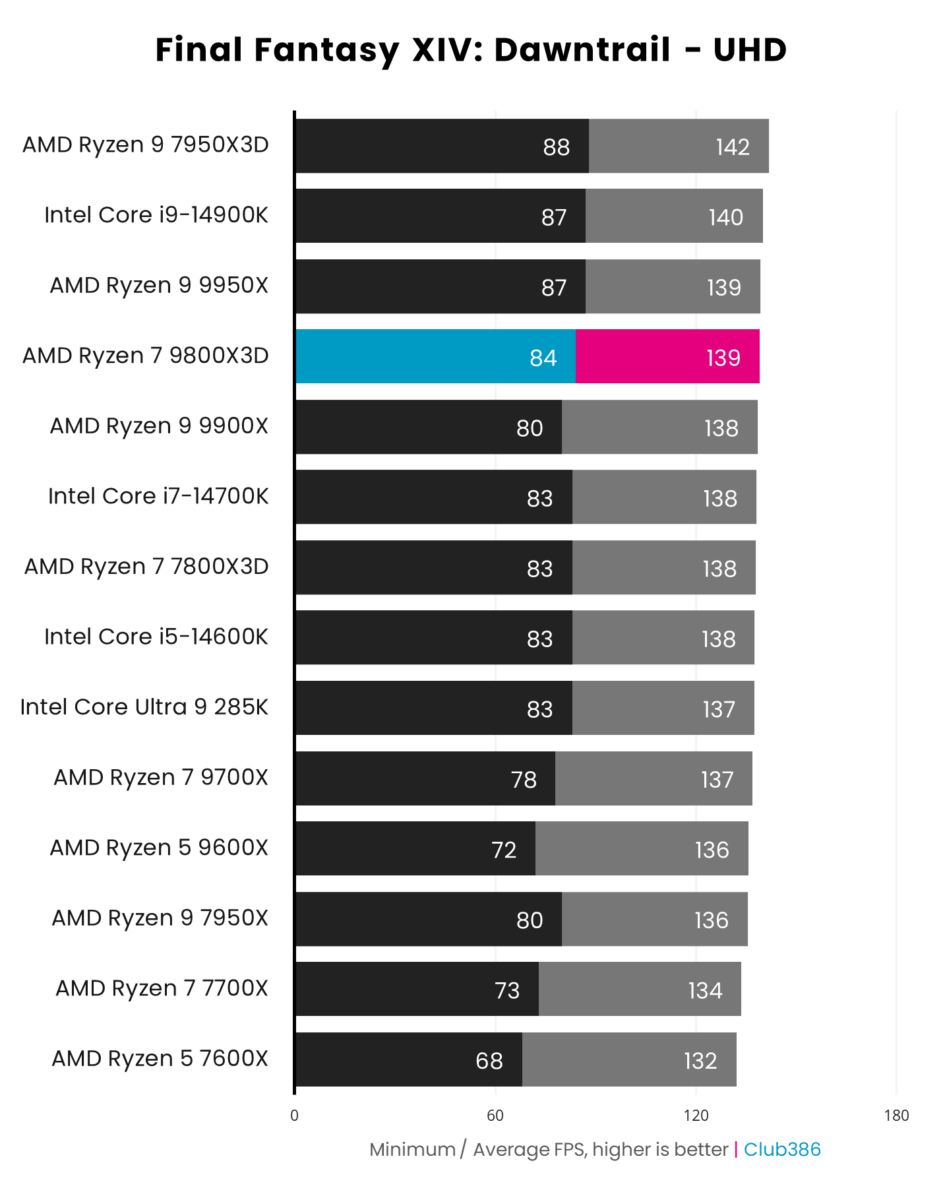
As expected, there’s nothing much between any CPU at 4K.
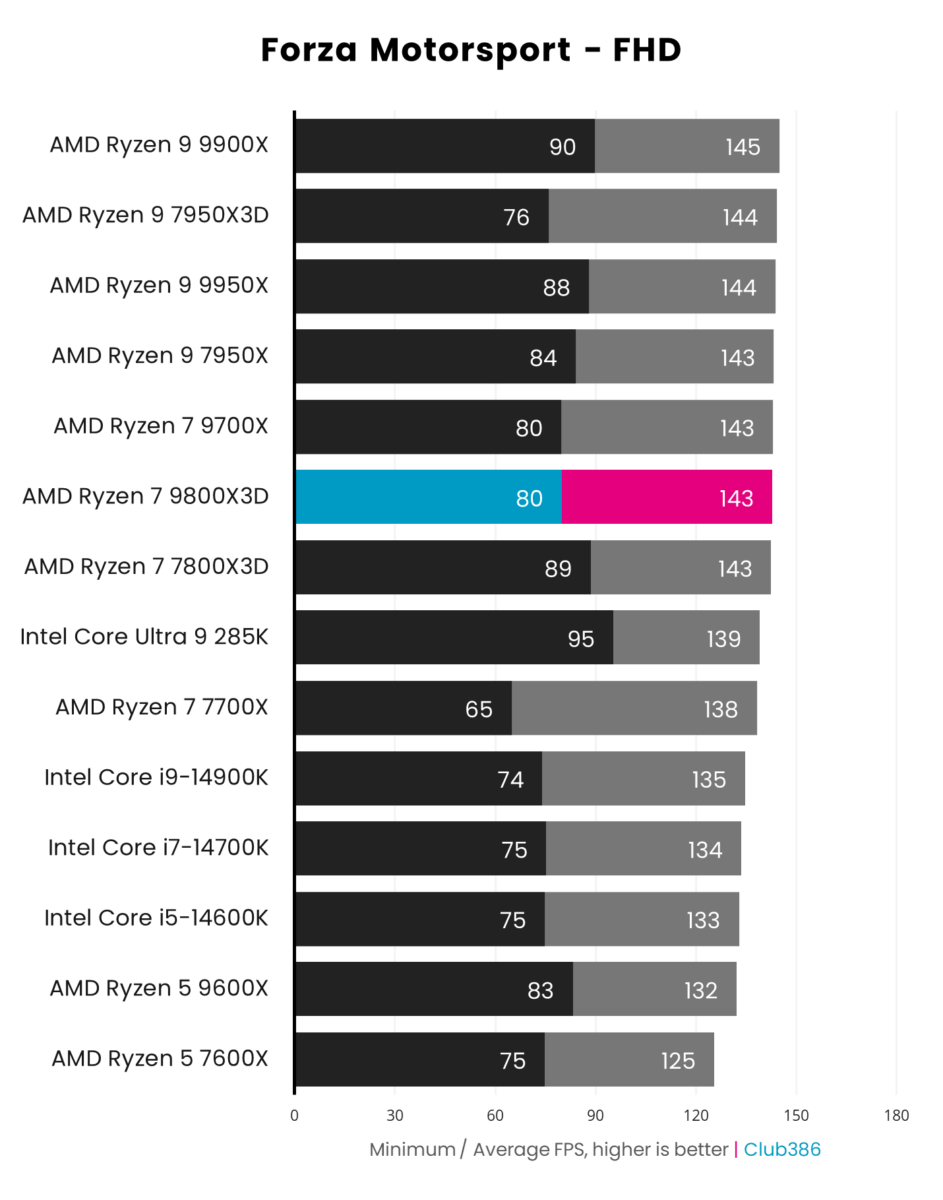
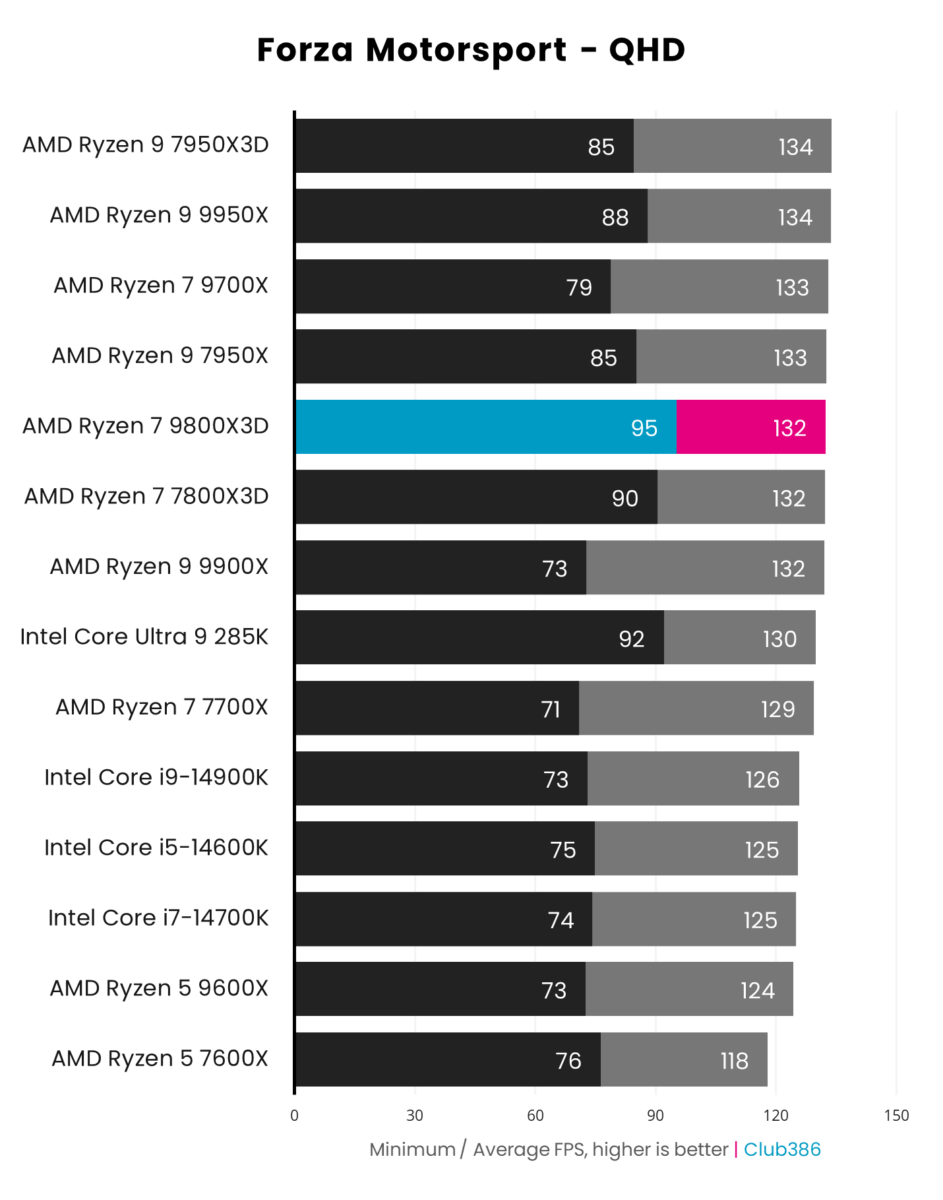
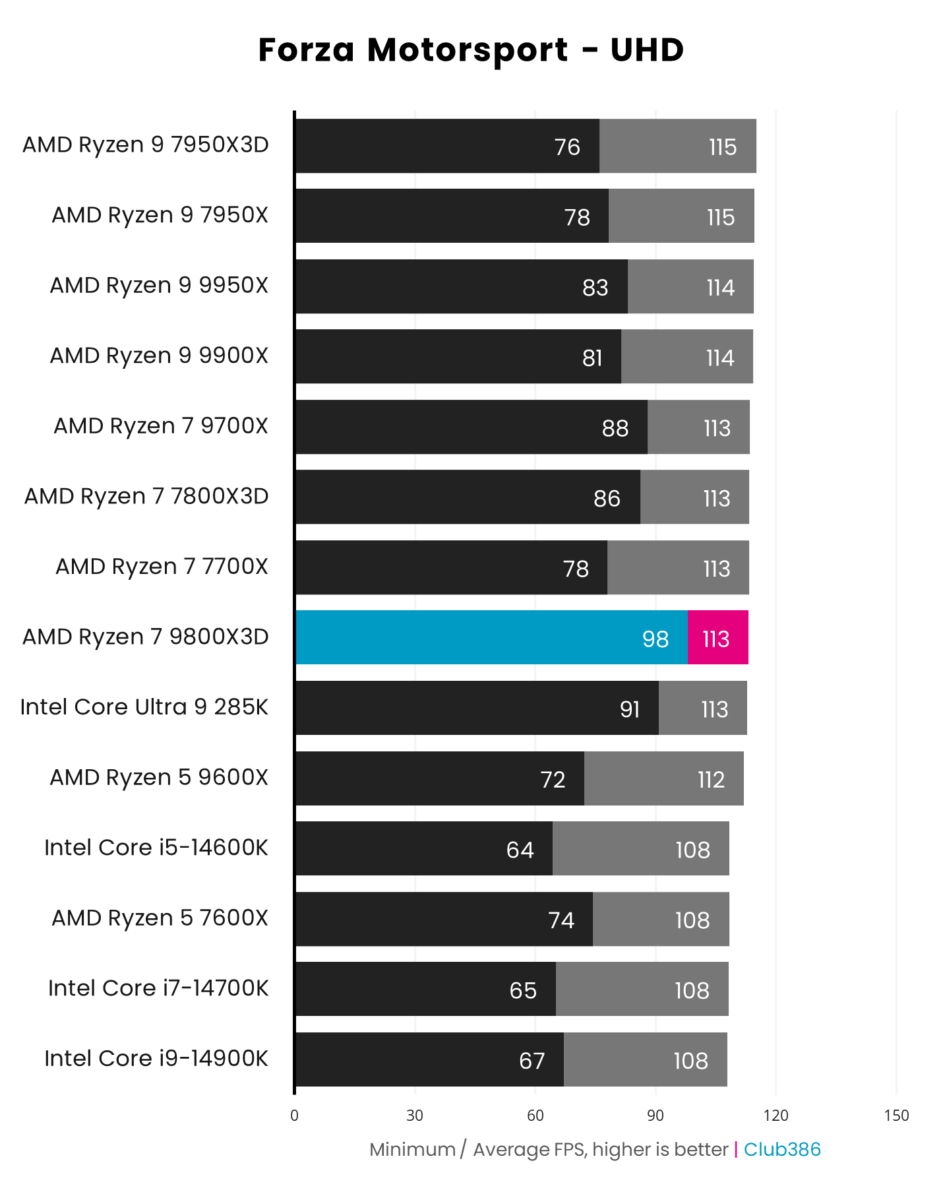
You know how I said some games are sensitive to X3D cache and others not. Forza Motorsport relies on the strength of the graphics card to deliver impressive framerates.
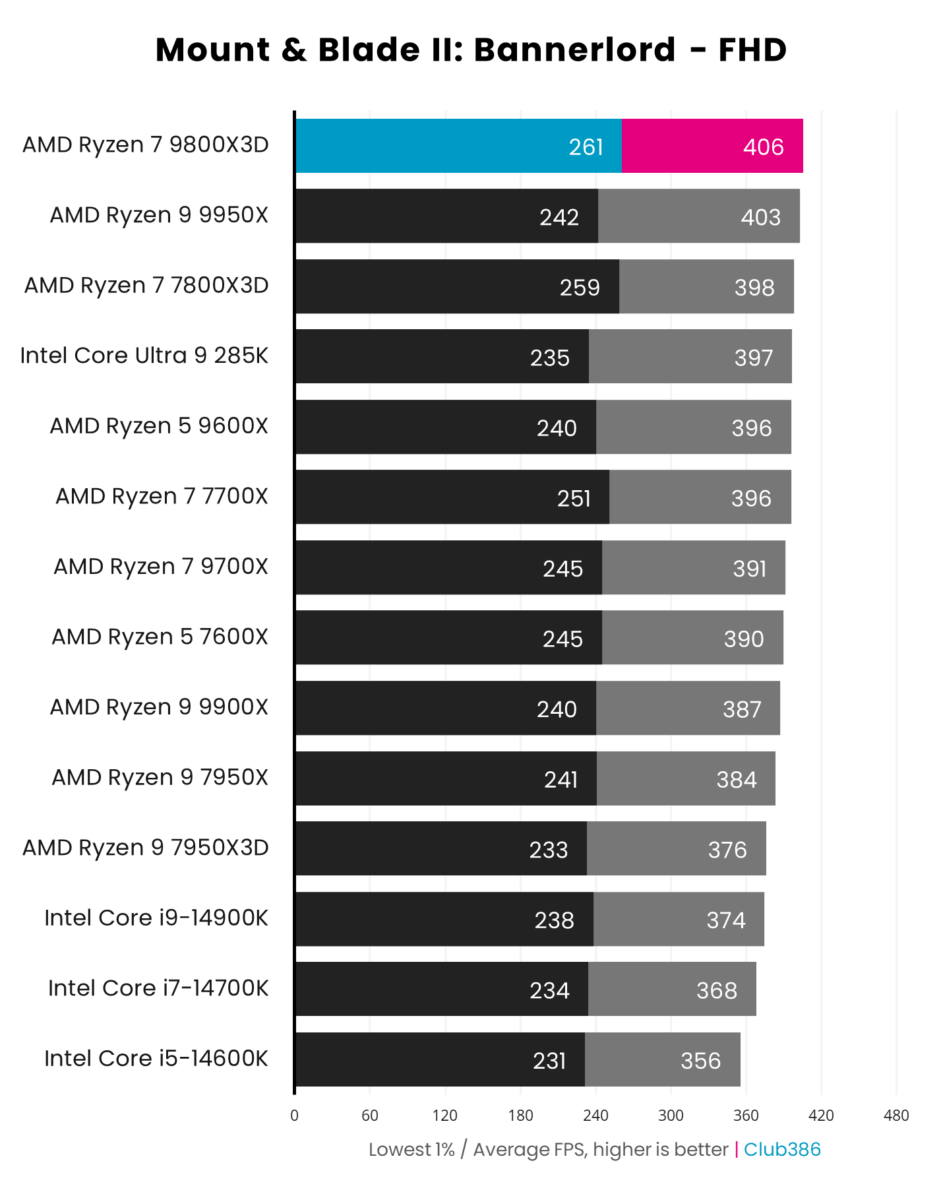
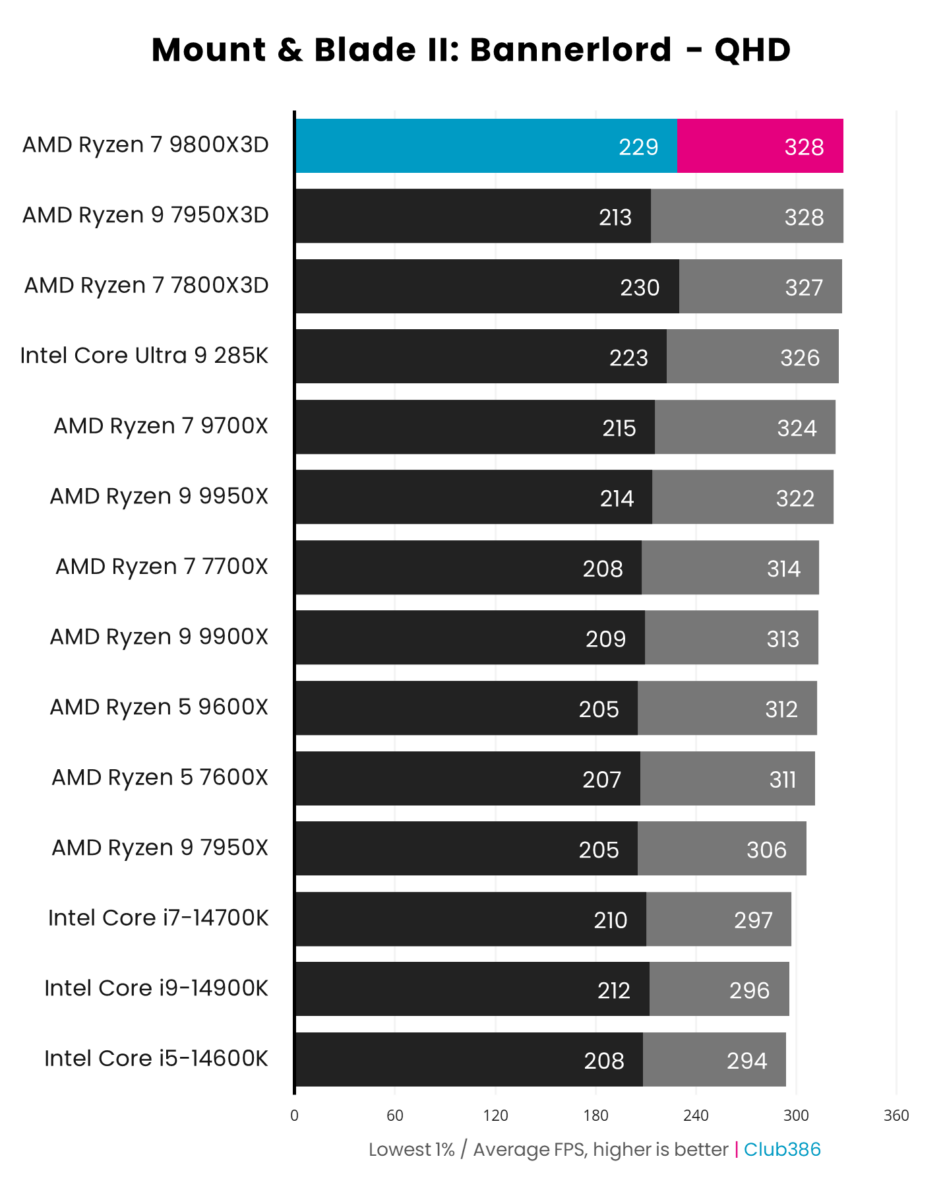
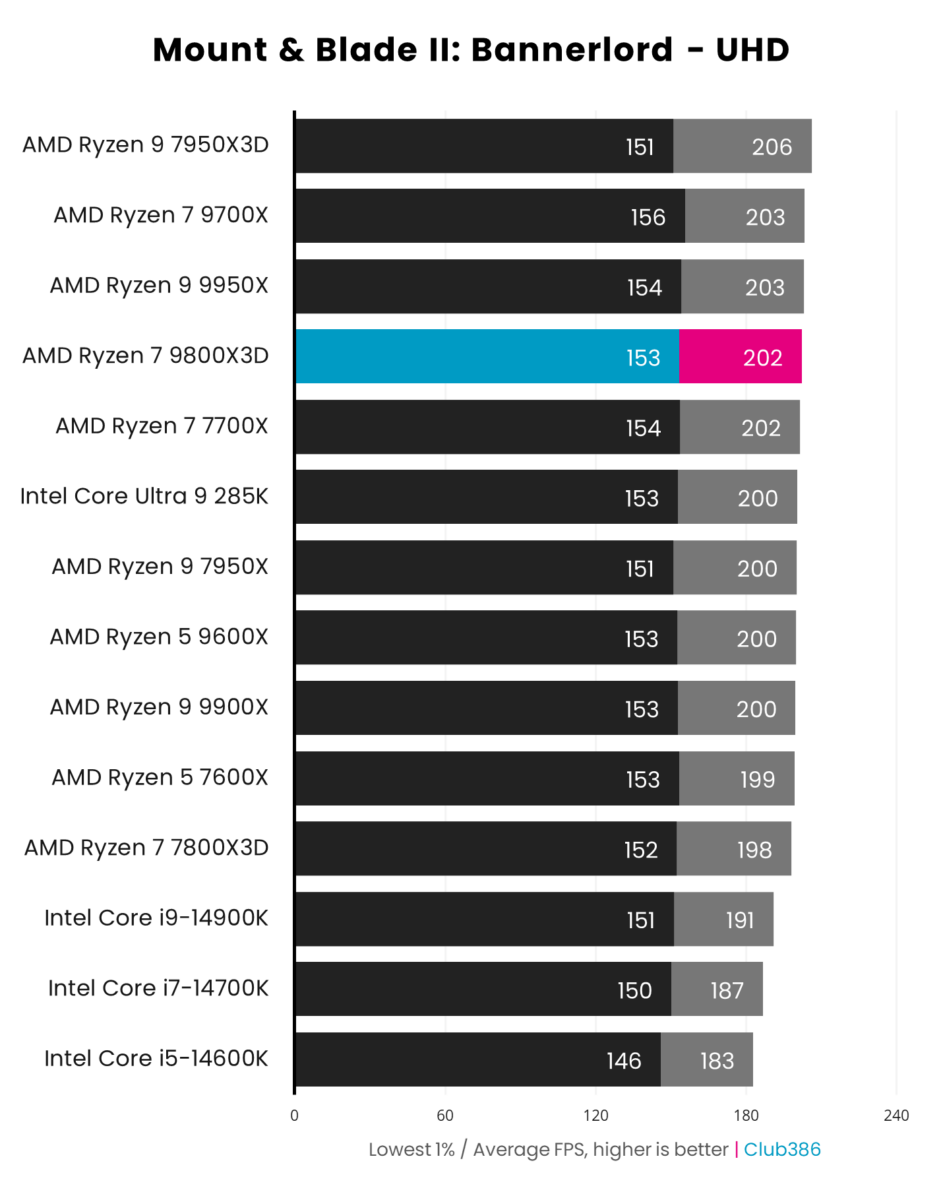
Another strong set of results cements the chip’s position as overall gaming head honcho.
Efficiency
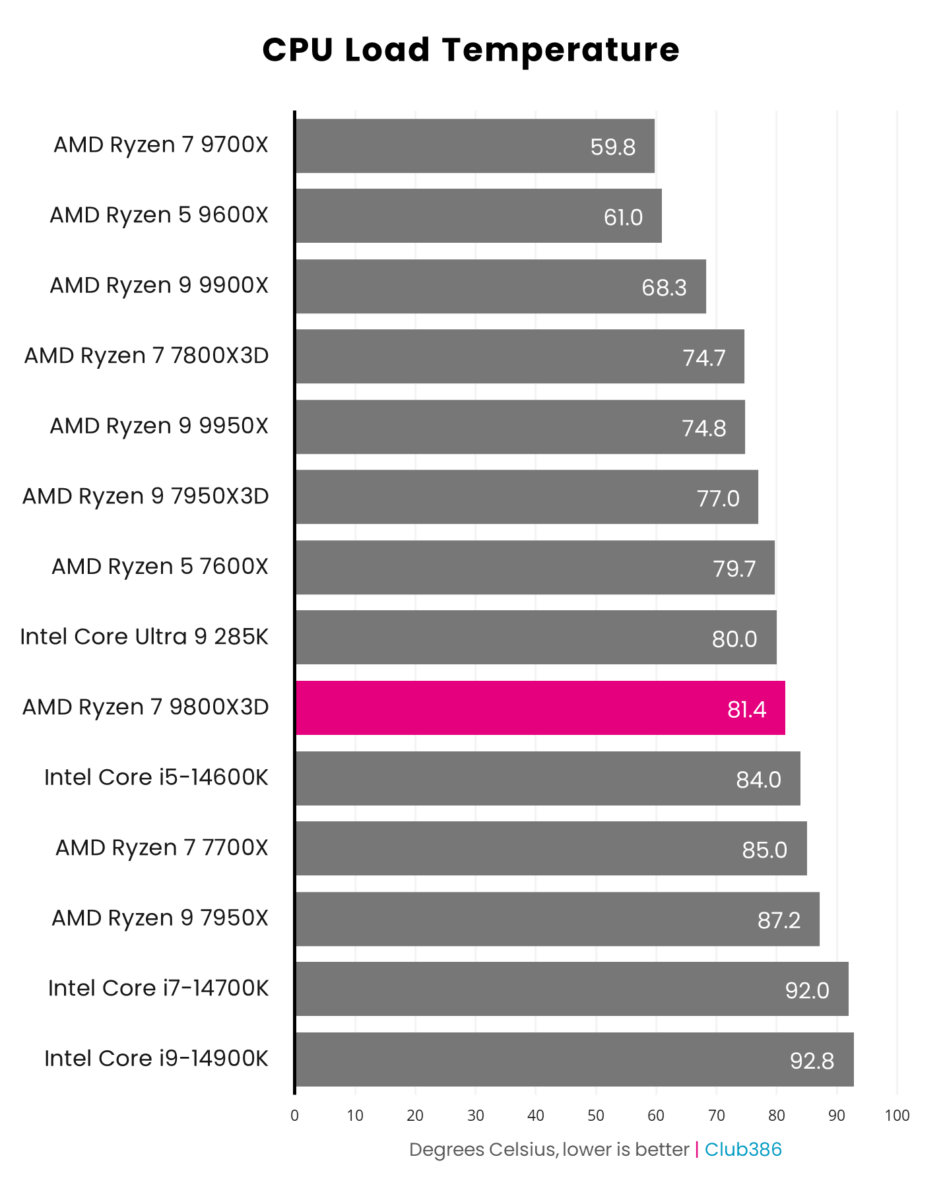
CPU load temperature is related to observed TDP and die configuration. It’s interesting to see 80°C+ on the review chip, though heat dissipation is actually very good when compared to Ryzen 7 7800X3D. That chip pulls around 81W PPT when under Cinebench cosh, compared with 147W for Ryzen 7 9800X3D, so an extra 7°C using the same cooling is impressive in its own right.
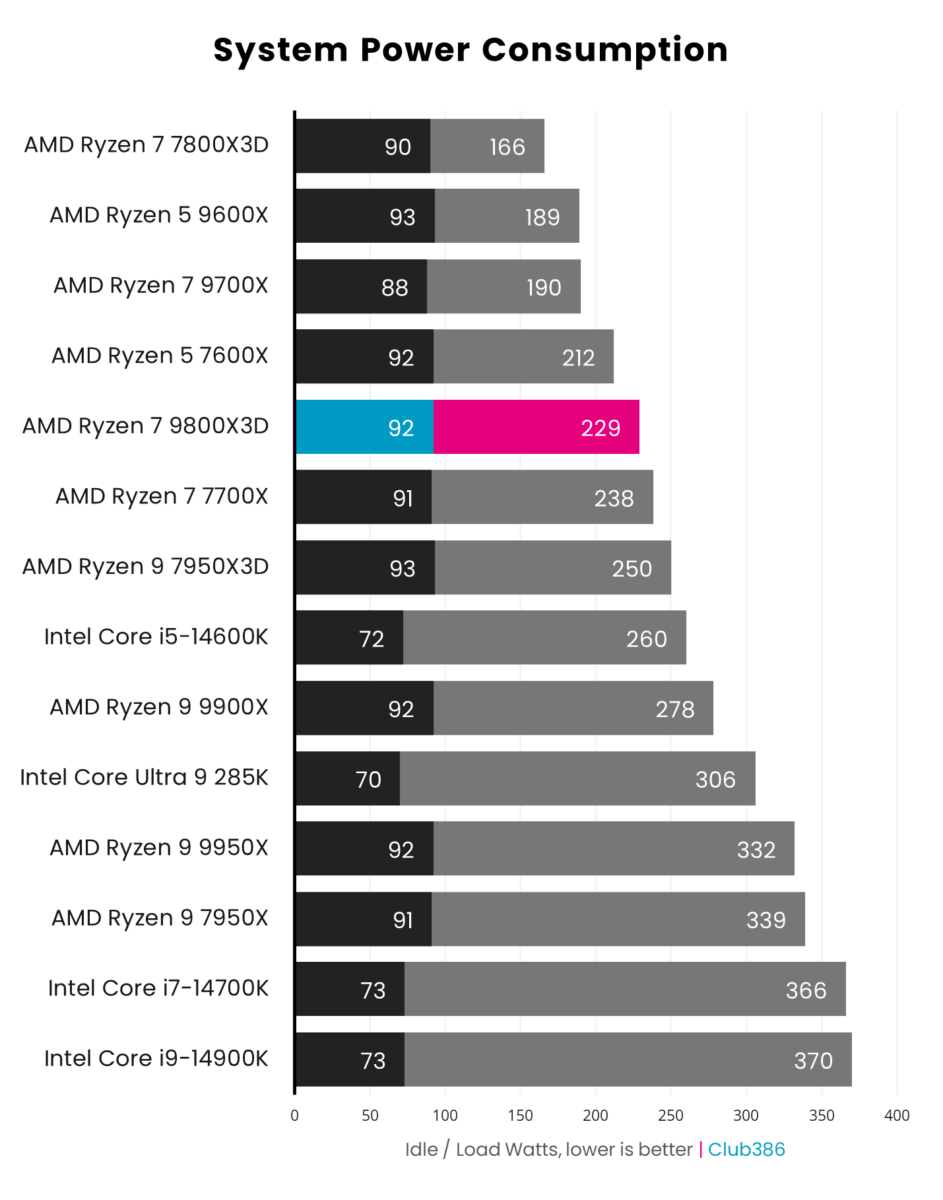
Here I’m looking at peak power consumption when running Cinebench 2024 multi-core for 10 minutes. The graph is at odds with the native 120W TDP ascribed to both 7800X3D and 9800X3D CPUs, though I do explain the difference as the latter maintains more residency at higher frequencies and voltages.
Furthermore, I can also describe the same system-wide power when gaming at FHD, QHD, and UHD. To do this, I run Assassin’s Creed Valhalla at the benchmark preset and note total power consumption for select gaming-focussed processors.
| Chip | FHD | QHD | UHD |
|---|---|---|---|
| Ryzen 7 9800X3D | 357W | 397W | 446W |
| Ryzen 7 7800X3D | 349W | 383W | 434W |
| Core Ultra 9 285K | 370W | 399W | 445W |
| Core i9-14900K | 460W | 492W | 512W |
| Ryzen 9 9950X | 433W | 465W | 487W |
| Ryzen 9 7950X3D | 382W | 413W | 450W |
Load power consumption is similar between aforementioned X3D chips. I’d expect as much because games don’t usually require heaps of multi-core muscle.
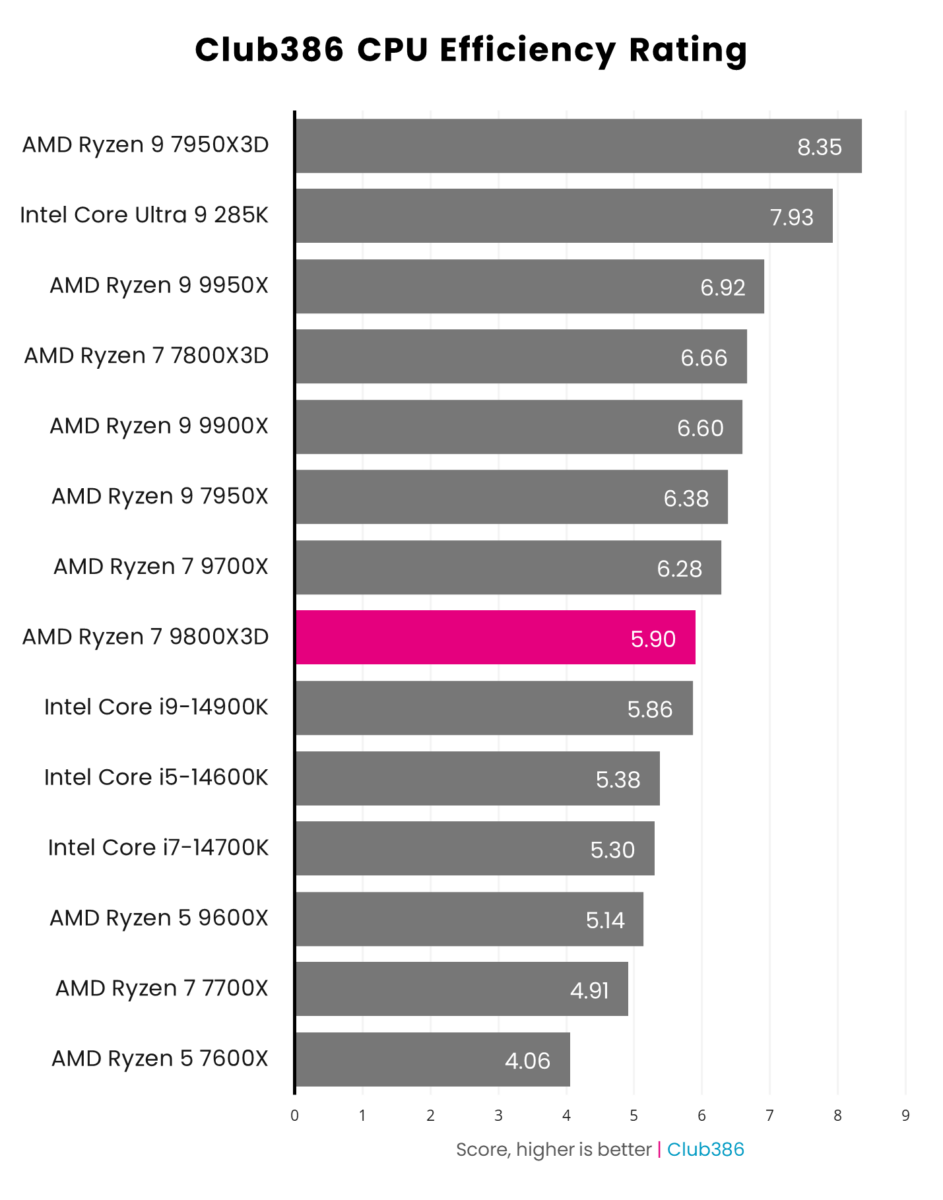
This graph divides Cinebench 2024 multi-core score by power consumption. Though 7800X3D is slower, it remains more efficient due to pulling meagre watts.
Overclocking
Appearing on X3D chips for the first time, overclocking opens up possibility of extracting even more performance. I do so by manually increasing all-core frequency and toggling voltages to find an amenable sweet spot. Turns out Ryzen 7 9800X3D doesn’t need the 1.28-1.31V mandated by AMD.
Rather, the chip is happy pootling along at an all-core 5.327GHz using around 1.22V. The net result is a minor uptick in frequency – remember, out-the-box all-core frequency is 5.220GHz – and reduction in system-wide power to the tune of 15W. A win-win in my book.
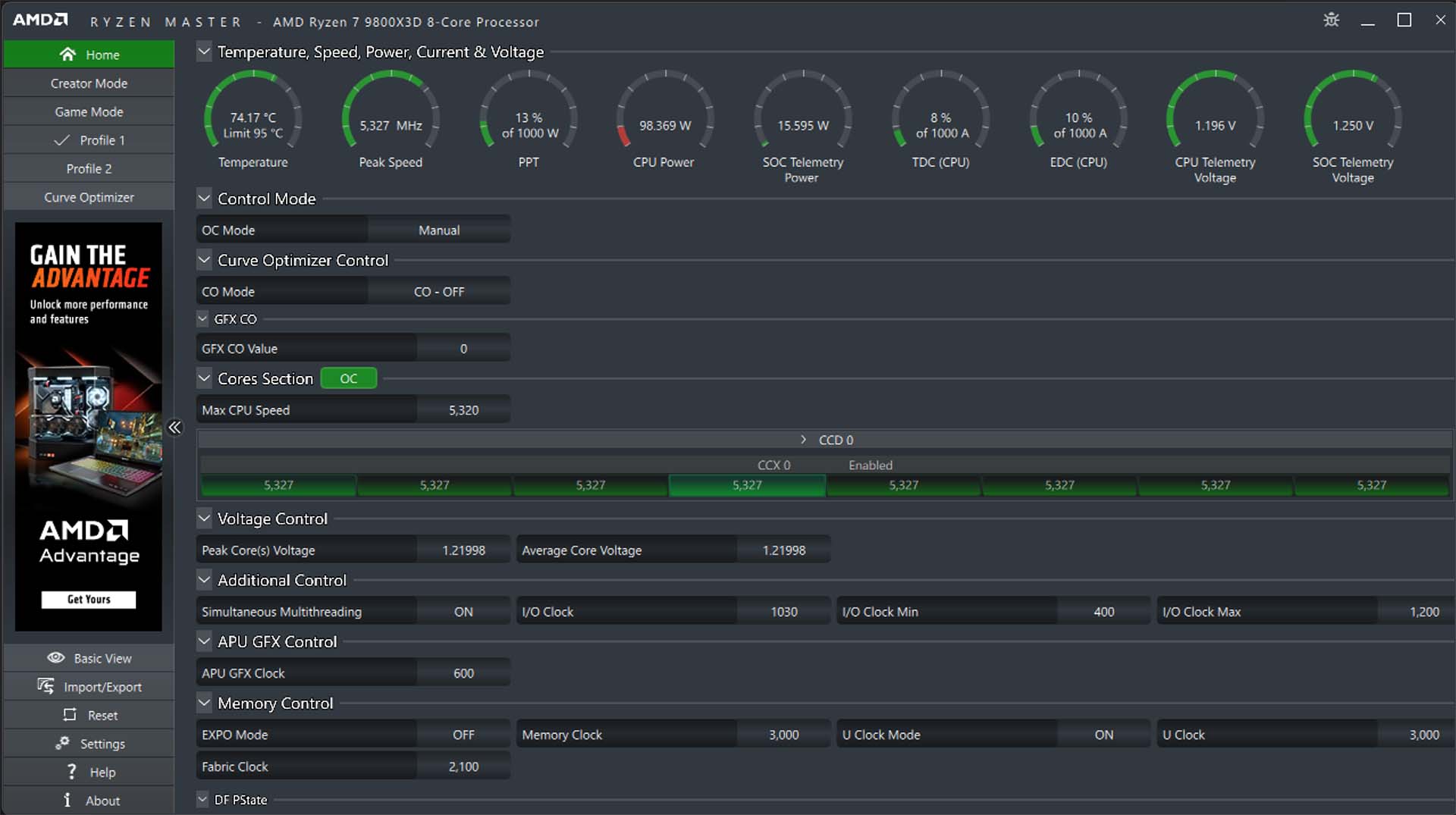
Notice the 107MHz higher all-core frequency, lower average voltage, and temperature dropping by around 7°C. This all sounds good, of course, but the strange thing is that Cinebench 2024 nT performance stays around the same, leaving me scratching my head. AMD’s PBO doesn’t do much either.
Shifting gears to gaming, Final Fantasy XIV: Dawntrail is most sensitive to the goodies rolled out by Ryzen 7 9800X3D. If you recall, stock performance at FHD is 300.9/128fps average and minimum. Run in this overclocked state, I see numbers of 302.6/124fps, which is practically the same.
I’ll delve deeper into overclocking as time goes on, but for now, it doesn’t seem worth it, unless you want to save a little power and shave temperature.
Conclusion
AMD’s decision to release a Zen 5-infused X3D chip based on the latest Ryzen 9000 Series is important in pushing the Ryzen brand to new and aspiring gamers who value framerate above all else.
Building on foundations laid down by two previous generations, key difference this time around is how the engineering team goes about laying down silicon. The X3D-specific cache is now located below the CPU cores, not above, and this change is significant because it enables this Ryzen to run at substantially higher frequencies and voltages than before.
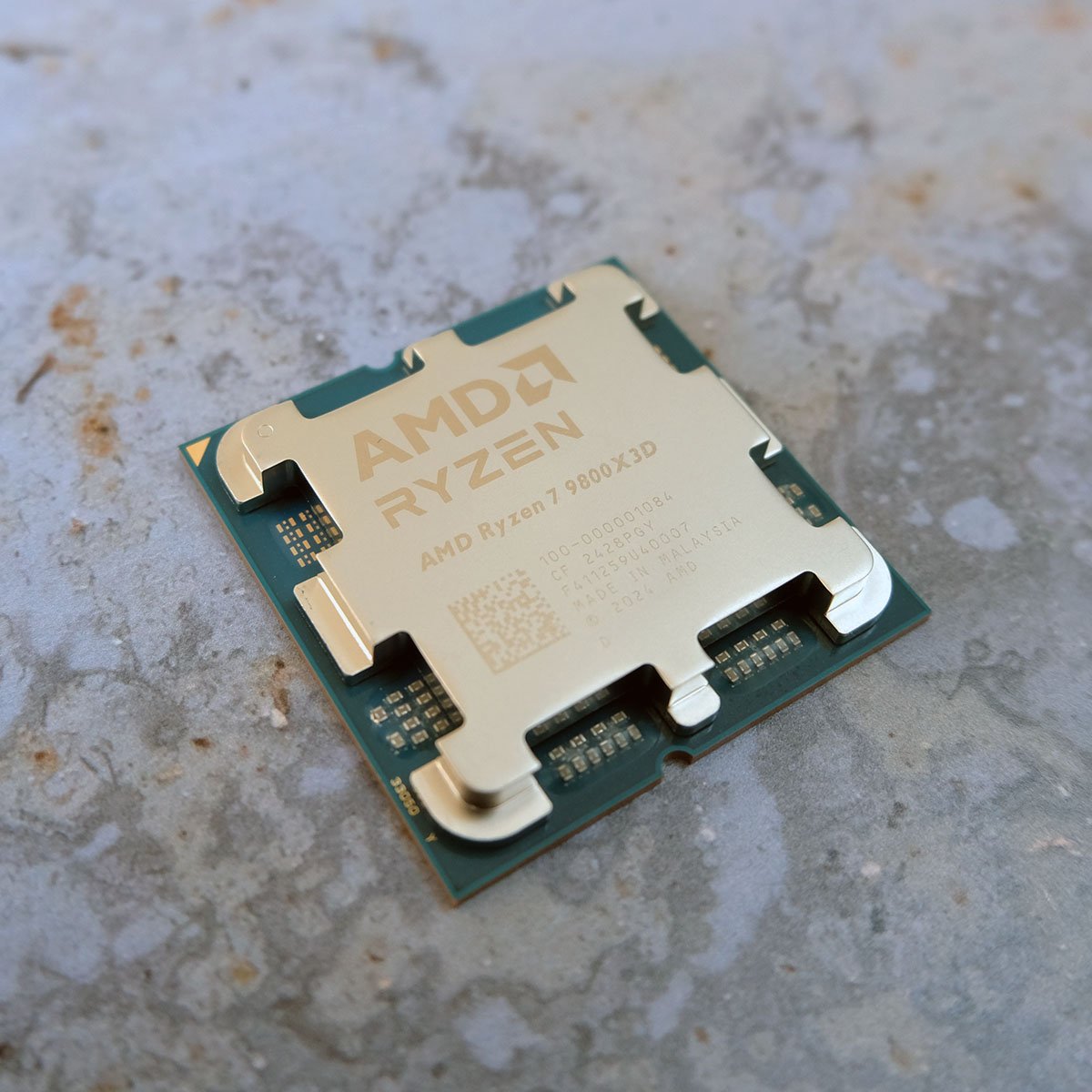
Operating fairly close to the headroom available, 8C16T Ryzen 7 9800X3D does rather well as a productivity workhorse; it’s actually faster than a straight-up Ryzen 7 9700X in all meaningful scenarios. But that’s not what you’re contemplating this processor for. Switching over to gaming reveals formidable strength in laying out framerates at lower resolutions.
There’s little doubt that Ryzen 7 9800X3D is the best gaming processor on the market. Back in 2022 we questioned whether gamers would be willing to sacrifice everyday performance in favour of gaming excellence; now they don’t have to. For a great many enthusiasts, this becomes the go-to chip for a complete gaming rig.
Verdict: Decent for productivity and excellent at doling out framerates, I recommend £450 Ryzen 7 9800X3D to gamers looking for that extra oomph.

